Samsung Electronics Co EKGN120A Multi-Band WCDMA/ LTE Portable Camera with WLAN and Bluetooth User Manual 2
Samsung Electronics Co Ltd Multi-Band WCDMA/ LTE Portable Camera with WLAN and Bluetooth Users Manual 2
Contents
- 1. Users Manual 1
- 2. Users Manual 2
- 3. Users Manual 3
Users Manual 2

Camera: Basic functions
51
Viewing photos and videos
To view taken photos or videos, tap the gallery icon. Scroll left or right to view the next or
previous image. (p. 97)
Taking photos or videos with voice commands
Use the voice recognition to take photos or videos with voice commands.
Tap
→
.
Say a shooting command, such as Smile, Cheese, or Record video.
To check more voice commands for controlling the camera, tap
→
.
Taking photos or videos with filter effects
Use the filter effects to take unique photos or videos.
Tap and select a filter effect. The available options vary by mode.
•
No effect
: Do not apply an effect.
•
Vignette
: This applies the retro-looking colours, high contrast, and strong vignette effect
of Lomo cameras.
•
Greyscale
: This makes the image black and white.
•
Sepia
: This red-shifts the background scenery.
•
Vintage
: This gives the image a vintage look and feel.
•
Turquoise
: This applies a soft turquoise colour effect.
•
Rainbow
: This applies a rainbow colour effect.
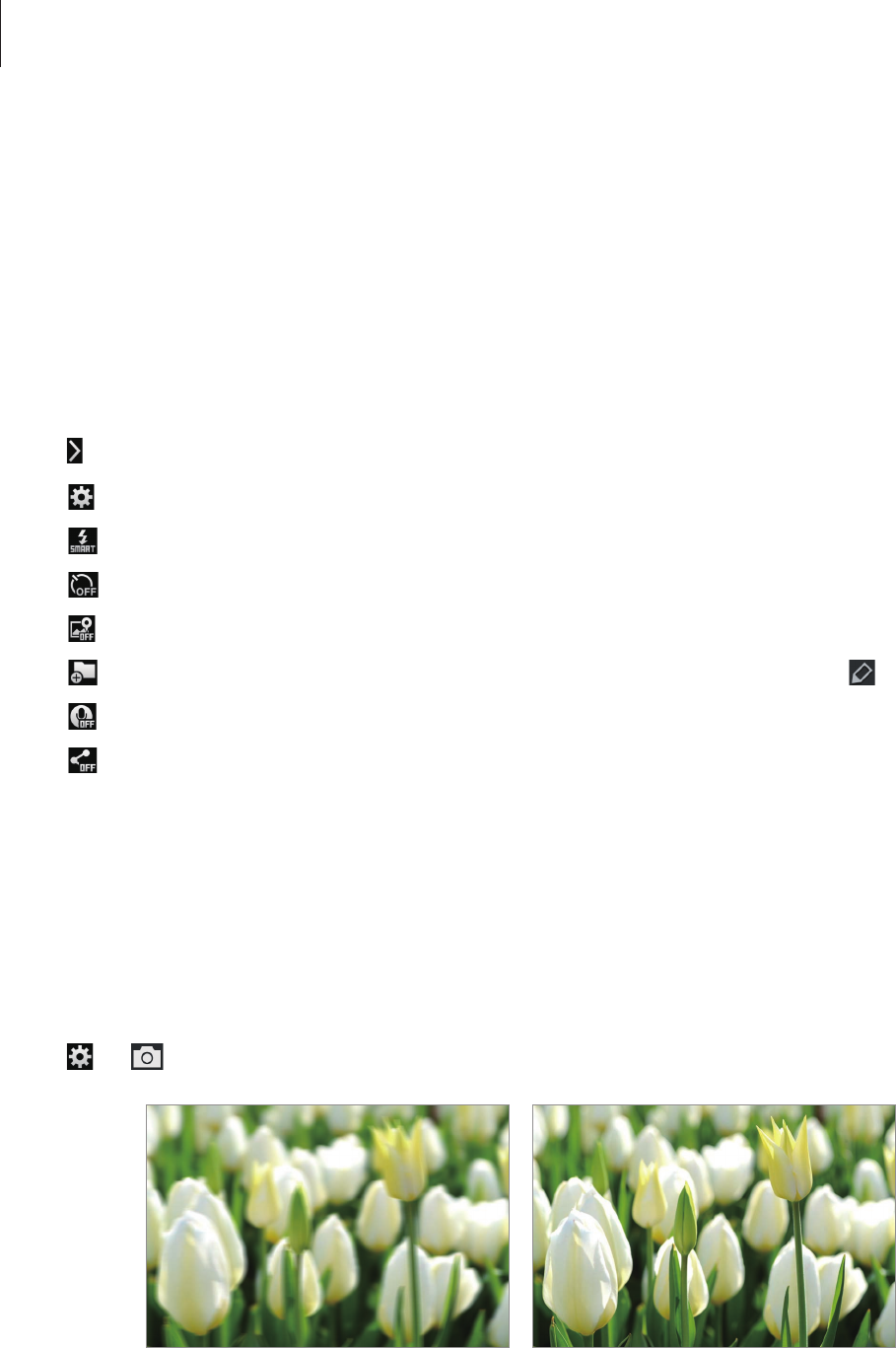
Camera: Basic functions
52
•
Comic
: This makes the image look like a comic book drawing.
•
Gothic noir
: This makes the image look like a black and white comic strip.
•
FishEye
: This blackens the edges of the frame and distorts objects to imitate the visual
effect of a fisheye lens.
Changing shooting options quickly
Tap to change shooting options quickly. The available options vary by mode.
•
: Configure settings for Camera.
•
: Activate or deactivate the flash.
•
: Use this to set delayed-time shots.
•
: Activate or deactivate the photo suggestion feature. (p. 110)
•
: Select a folder for saving photos or videos. To create a new folder, tap .
•
: Activate or deactivate the voice recognition to take photos or videos.
•
: Activate or deactivate the sharing options.
Reducing camera shake
Use the Optical Image Stabiliser (OIS) option to reduce or eliminate blurriness from camera
shake.
If the lens has an OIS switch, set the switch to ON to use the OIS function.
Tap
→
→
OIS (anti-shake)
, and select an option.
Before correction After correction
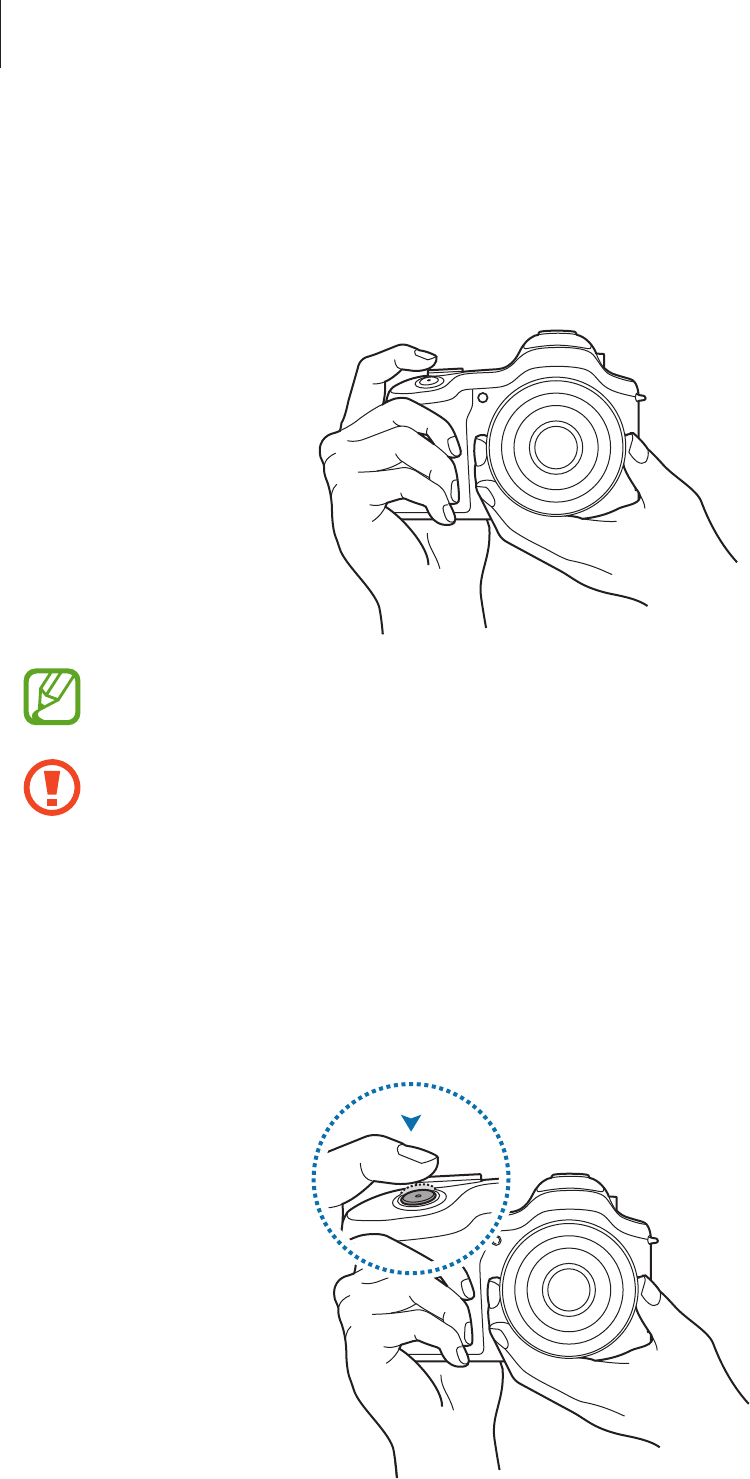
Camera: Basic functions
53
Tips for taking clearer photos
Holding the camera correctly
Make sure not to block the screen, lens, flash, or microphone.
Make sure not to expose the lens to direct sunlight. This may discolour the image
sensor, or cause it to malfunction.
Half-pressing the Shutter button
Press the Shutter button halfway down to adjust the focus. The camera adjusts the focus,
exposure, and white balance automatically, and the focus frame turns green. The focus frame
turns red if not focused.
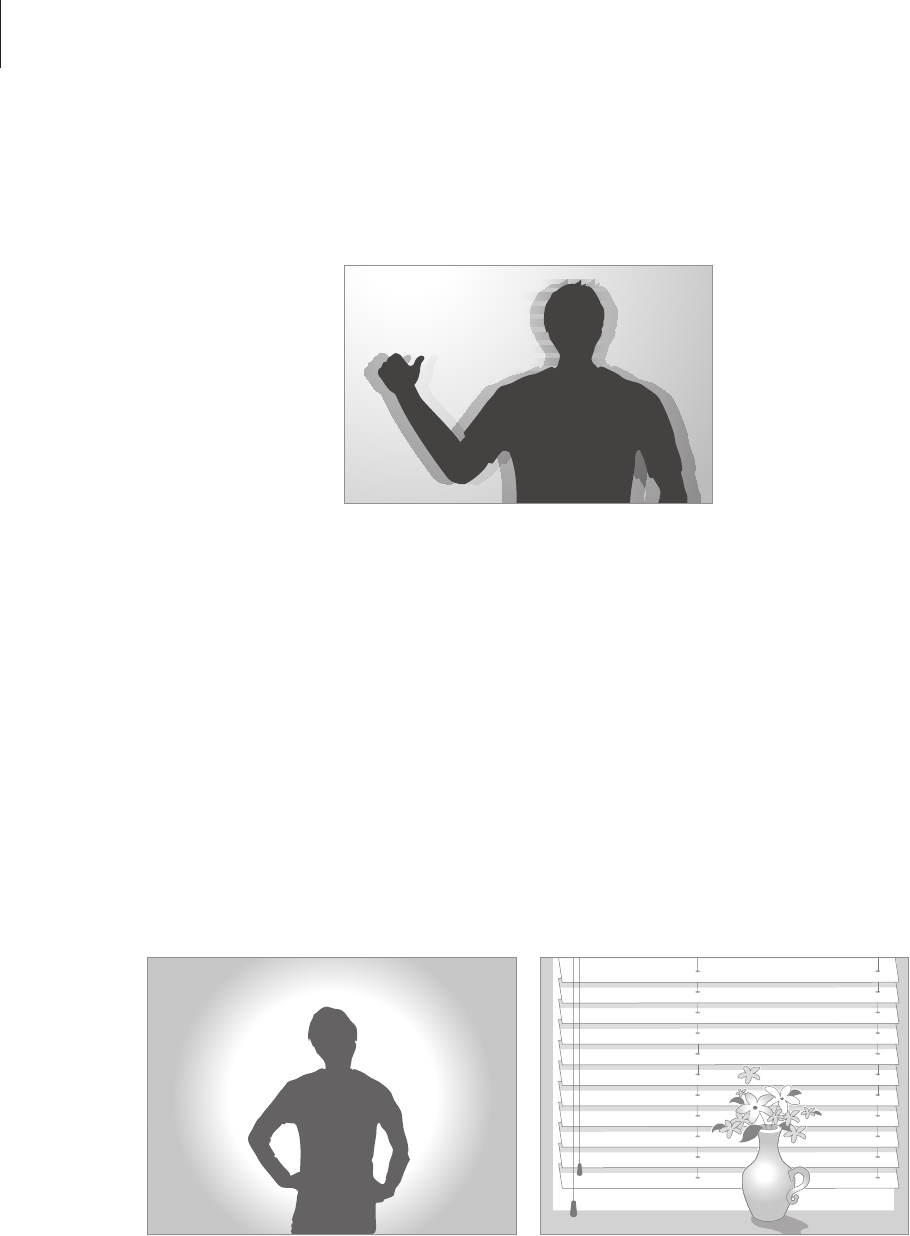
Camera: Basic functions
54
Reducing camera shake
Set the Optical Image Stabiliser (OIS) option to reduce camera shake optically. (p. 52)
Keeping the subject in focus
Focusing on the subject may be difficult in the following conditions:
•
When the contrast between the subject and background is low. For example, the subject
is wearing clothing that is similar in colour to the background.
•
The light behind the subject is too bright.
•
The subject is shiny or reflective.
•
The subject includes horizontal patterns, such as blinds.
•
The subject is not positioned in the centre of the frame.
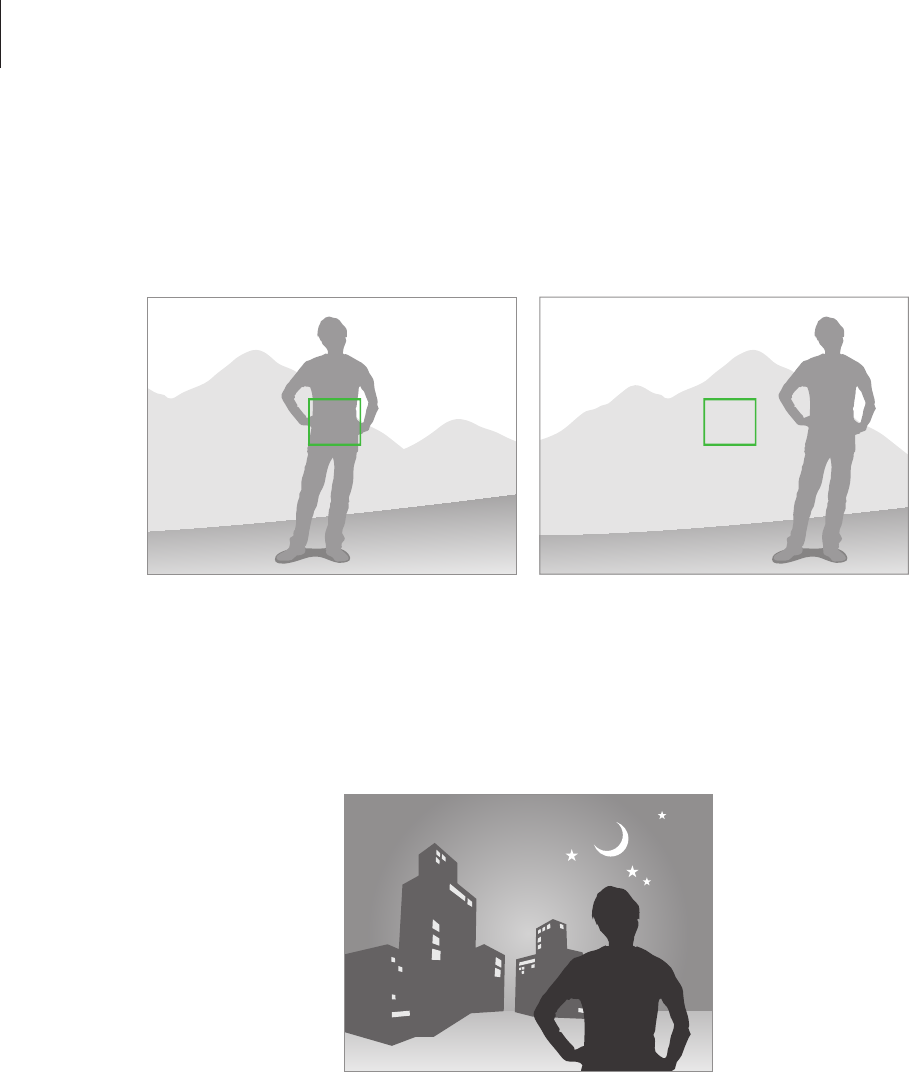
Camera: Basic functions
55
Using the focus lock
Half-press the Shutter button to focus. When the subject is focused, you can change the
composition. When you are ready, press the Shutter button to take the photo.
When taking photos in low-light conditions
•
Turn the flash on to take photos in low-light conditions. (p. 83)
•
Adjust the ISO sensitivity. (p. 77)

Camera: Basic functions
56
When subjects are moving rapidly
Use the continuous shooting option to take photos of moving subjects. (p. 63, p. 81)
To take several photos continuously, use memory cards with faster writing speeds
(micro SDHC Class10 or higher).
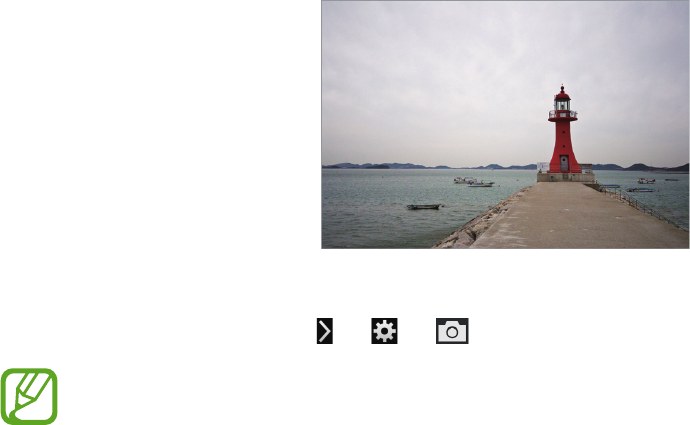
57
Camera: Shooting modes
Auto
Use this to take photos with scene modes selected automatically by the camera. In this
mode, the camera recognises surrounding conditions and automatically adjusts factors that
contribute to exposure, including the shutter speed, aperture value, metering, and white
balance. As the camera controls most of the functions, some shooting options are limited.
This mode is useful for capturing quick snapshots with the least amount of adjustment.
Tap
MODE
→
Auto
.
To display an icon for a scene mode at the top right of the preview screen when you half-
press the Shutter button, tap
→
→
→
Detection display
→
On
.
•
The camera may detect different scenes, even the same subjects, depending on
external factors, such as camera shake, lighting, and distance to the subject.
•
If the camera does not recognise an appropriate scene mode, it uses the default
settings for this mode.
•
Even if it detects a face, the camera may not select a portrait mode depending on
the subject’s position or lighting.
•
In this mode, the camera consumes more battery power due to constant changing
of settings when selecting appropriate modes.
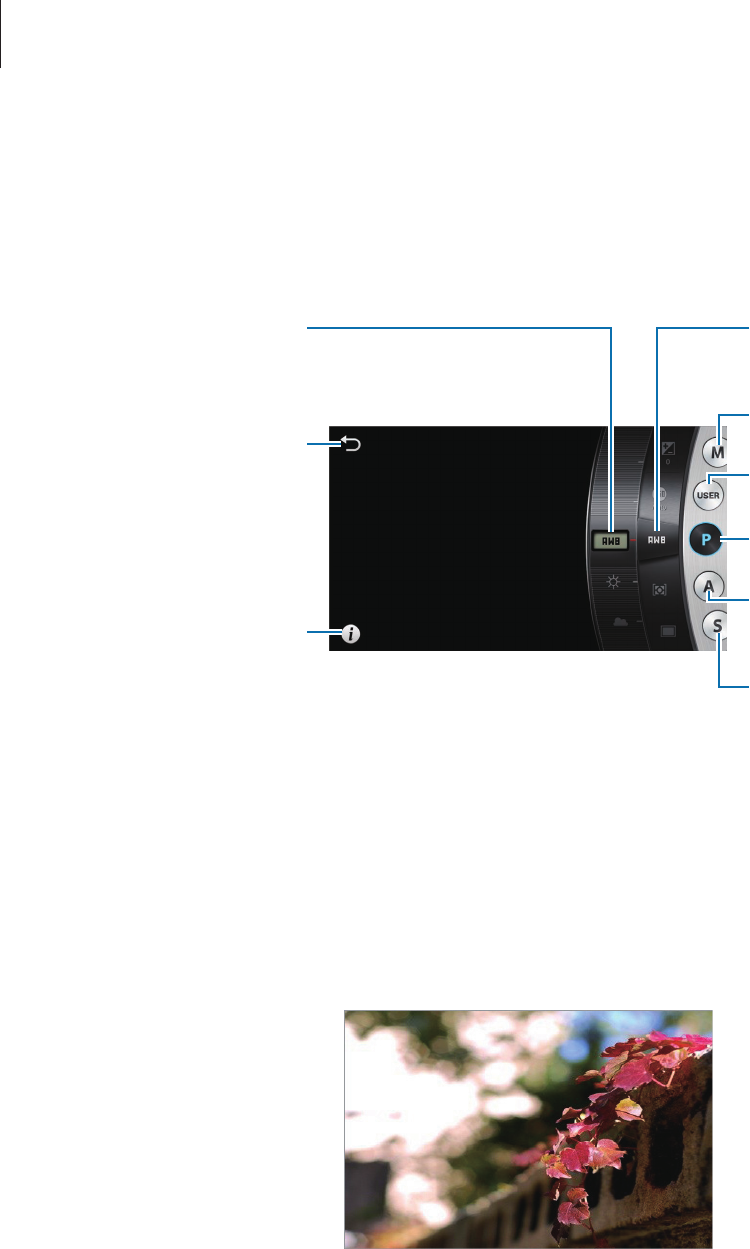
Camera: Shooting modes
58
Expert
Use this to take photos and videos with manual adjustment of various shooting options,
including the shutter speed, aperture value, exposure value, and ISO sensitivity.
Return to the previous
screen.
Display descriptions of
modes and functions.
Rotate to change the value
for the shooting option.
Rotate to select a shooting
option.
Use manual mode.
Use user mode.
Use program mode.
Use aperture priority
mode.
Use shutter priority mode.
Program mode
In this mode, the camera automatically adjusts the shutter speed and aperture value so that
an optimal exposure value can be achieved. This mode is useful when you want to capture
shots of constant exposure while being able to adjust other settings.
Tap
MODE
→
Expert
→
P
, and set the desired shooting options.
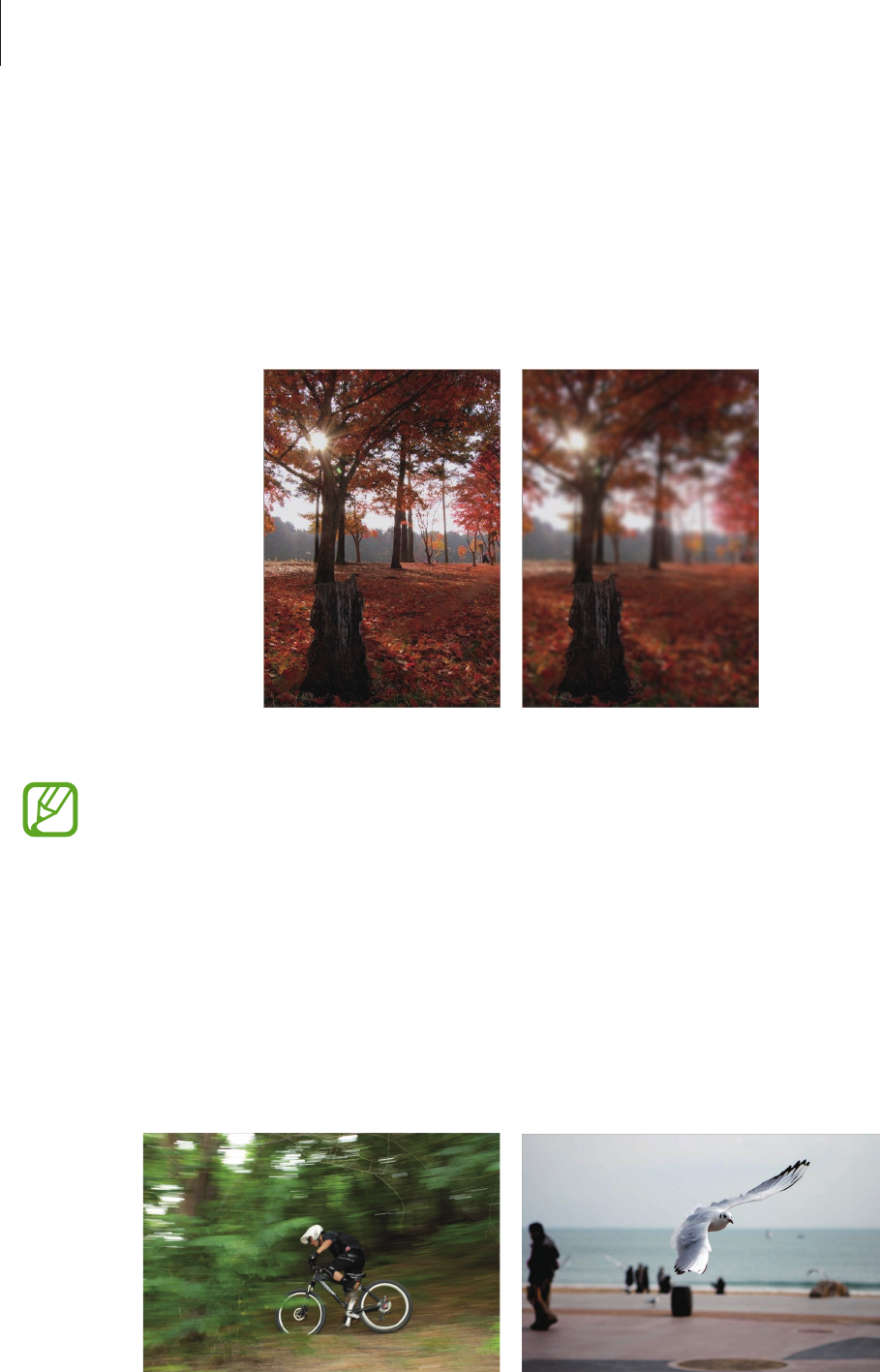
Camera: Shooting modes
59
Aperture priority mode
In this mode, the camera automatically calculates shutter speed according to the aperture
value you choose. You can adjust the depth of field (DOF) by changing the aperture value.
This mode is useful for taking portraits and landscape shots.
Tap
MODE
→
Expert
→
A
, and set the desired shooting options.
Large depth of field Small depth of field
In low-light settings, you may need to increase the ISO sensitivity to prevent blurry
photos.
Shutter priority mode
In this mode, the camera automatically adjusts the aperture value according to the shutter
speed you choose. This mode is useful for taking photos of fast-moving subjects or for
creating tracer effects in a photo.
Tap
MODE
→
Expert
→
S
, and set the desired shooting options.
Slow shutter speed Fast shutter speed

Camera: Shooting modes
60
To compensate for the reduced amount of light allowed by fast shutter speeds, adjust
the aperture and let in more light. If your photos are still too dark, increase the ISO
sensitivity.
Manual mode
This mode lets you adjust the shutter speed and aperture value manually. In this mode, you
can fully control the exposure of your photos. This mode is useful in controlled shooting
environments, such as a studio, or when it is necessary to fine-tune camera settings. This
mode is also recommended for shooting night scenes or fireworks.
Tap
MODE
→
Expert
→
M
, and set the desired shooting options.
•
If you set a high ISO sensitivity or open the shutter for a long time, image noise
may increase.
•
Use a tripod and shutter release to prevent your camera from shaking.
•
The longer you open the shutter, the longer it takes to save a photo. Do not turn
the camera off while the camera saves a photo.
Using the bulb feature
Use this feature to shoot night scenes or the night sky. While you are pressing the Shutter
button, the shutter is left open so you can create moving light effects.
In manual mode, set the shutter speed to
Bulb
.
User mode
Use this to create and save your own shooting mode by adjusting settings.
Tap
MODE
→
Expert
→
P
/
A
/
S
/
M
, and set the desired shooting options. Then, tap
→
→
Save as User mode
to save the current settings.
To access user mode, tap
MODE
→
Expert
→
USER
.
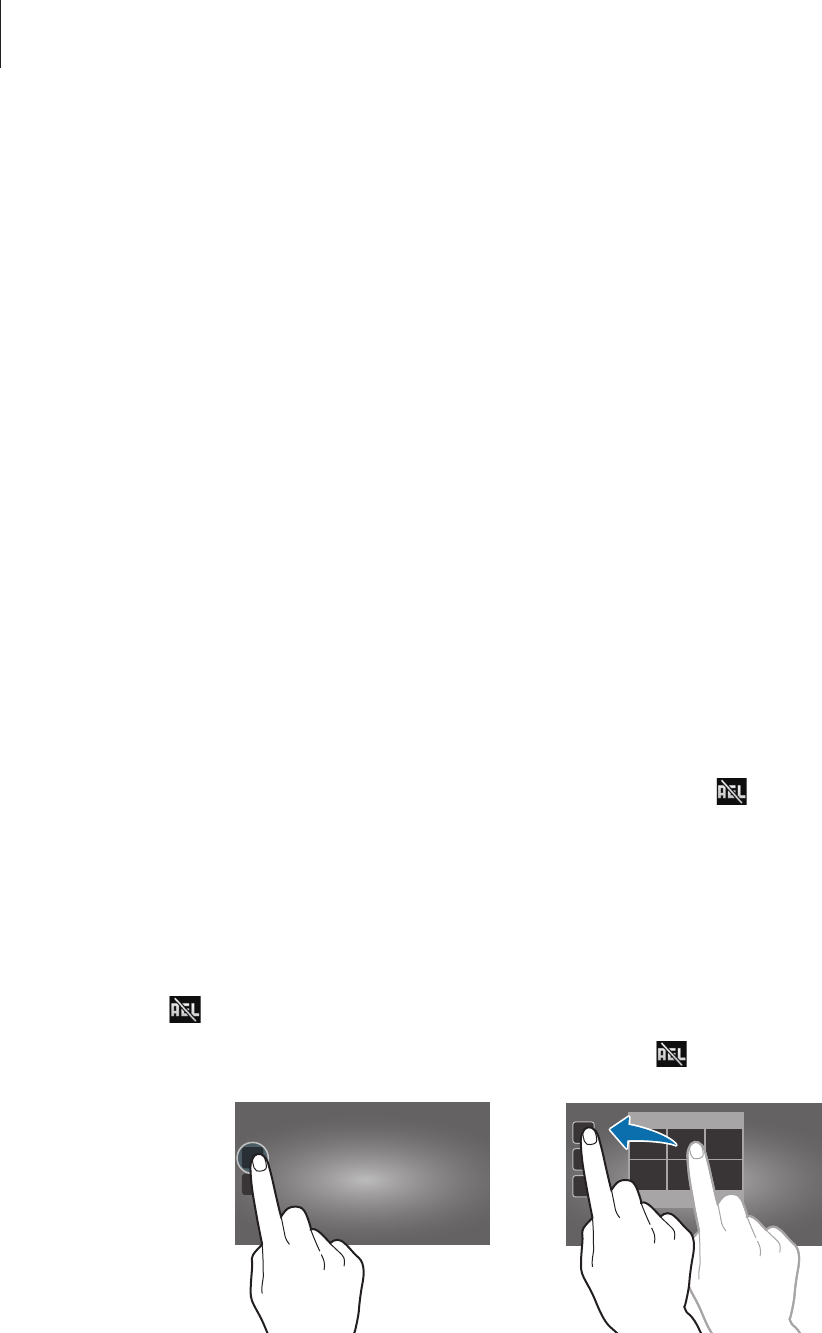
Camera: Shooting modes
61
Adjusting major shooting options
In expert mode, you can adjust the shutter speed, aperture value, exposure value, or ISO
sensitivity with the Command dial and the i-Function button.
Using the Command dial
Press and hold the Command dial. Rotate it to move to a desired option and press it to select
the option. Rotate it to adjust a value, and then press it to confirm the change.
Using the i-Function button
Press the i-Function button on the lens repeatedly to select an option, and then rotate the
focus ring on the lens or the Command dial on the camera to adjust the value.
Using the auto exposure lock
When you cannot achieve an appropriate exposure because of a strong colour contrast, lock
the exposure, and then take a photo.
To lock the exposure value, adjust the photo’s exposure, and tap to lock the exposure. Aim
the lens where you desire, and then press the Shutter button.
Shortcuts
Add or remove shortcuts for easy access to the camera’s various options.
Tap and hold or another shortcut icon.
Tap and hold an option and drag it to the desired location. cannot be moved.

Camera: Shooting modes
62
Smart
Use this to take photos with predefined settings for various scenes.
Smart suggest
Use this to take photos with one of the smart modes that the camera automatically suggests.
Tap
MODE
→
Smart
→
Smart suggest
.
Half-press the Shutter button, select a mode from the suggested list, and then press the
Shutter button to take a photo. If you do not select a mode from the suggested list, the
camera will take a photo in Auto mode.
Beauty face
Use this to take photos with lightened faces for gentler images.
Tap
MODE
→
Smart
→
Beauty face
.
Press the Shutter button to take a photo, and the camera automatically adjusts the photo,
and then saves it.
Best photo
Use this to take multiple photos in a short time, and then choose the best photos among
them.
Tap
MODE
→
Smart
→
Best photo
.
Press the Shutter button to take multiple photos. When
Gallery
opens, tap and hold
thumbnails of photos to save, and then tap
Save
.
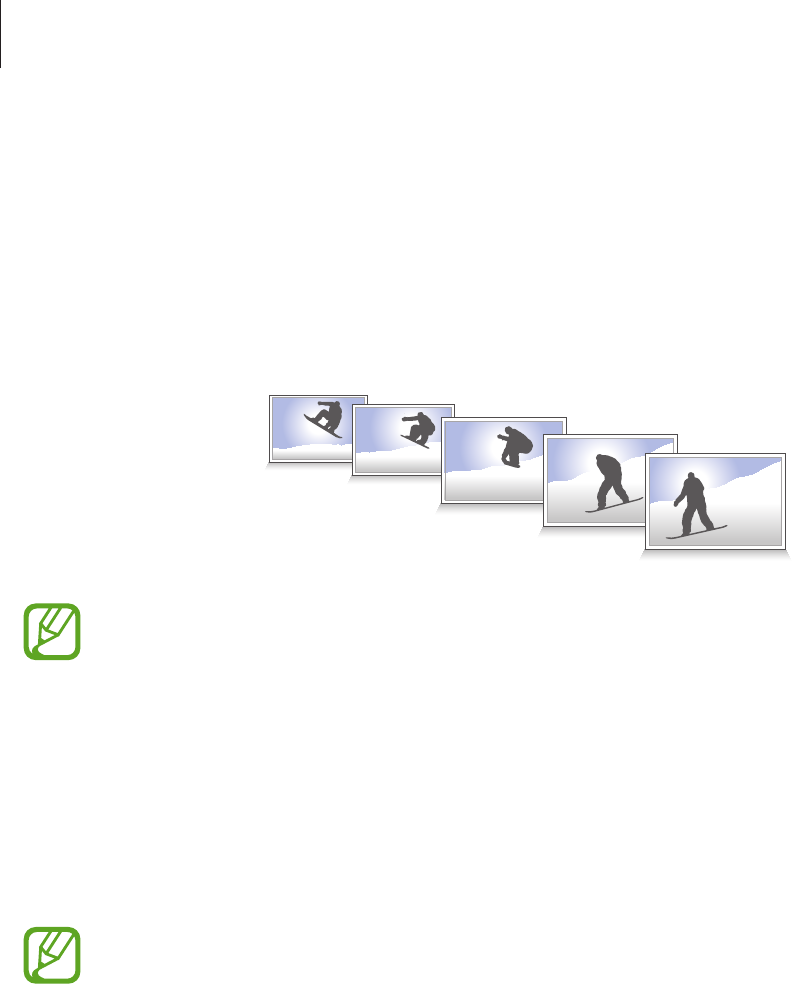
Camera: Shooting modes
63
Continuous shot
Use this to take a series of photos of moving subjects.
Tap
MODE
→
Smart
→
Continuous shot
.
While holding the camera steady, press and hold the Shutter button to take several photos
continuously.
To take several photos continuously, use memory cards with faster writing speeds
(micro SDHC Class10 or higher).
Golf shot
Use this to take consecutive photos of a golf-swing to analyse technique.
Tap
MODE
→
Smart
→
Golf shot
.
Press the Shutter button. When the camera detects a golf-swing, it takes multiple photos.
•
This feature is not available in portrait orientation.
•
Using a tripod is recommended.

Camera: Shooting modes
64
Best face
Use this to take multiple group shots at the same time and combine them to create the best
possible image.
Tap
MODE
→
Smart
→
Best face
.
Press the Shutter button to take multiple photos. To get the best shot, hold the camera steady
and remain still while taking photos. When
Gallery
opens, tap the yellow frame on each face,
and choose the best individual face for the subject. After choosing a face for each individual,
tap
Save
to merge the images into a single photo, and save it.
Color bracket
Use this to take three photos with different colour effects continuously.
Tap
MODE
→
Smart
→
Color bracket
.
Kids shot
Use this to play a funny sound to get a baby’s attention when shooting.
Tap
MODE
→
Smart
→
Kids shot
.
Press the Shutter button. The camera emits the attention sound and takes multiple photos
when it detects a smiling face.
To change the attention sound, tap
→
→
→
Attention sound
.
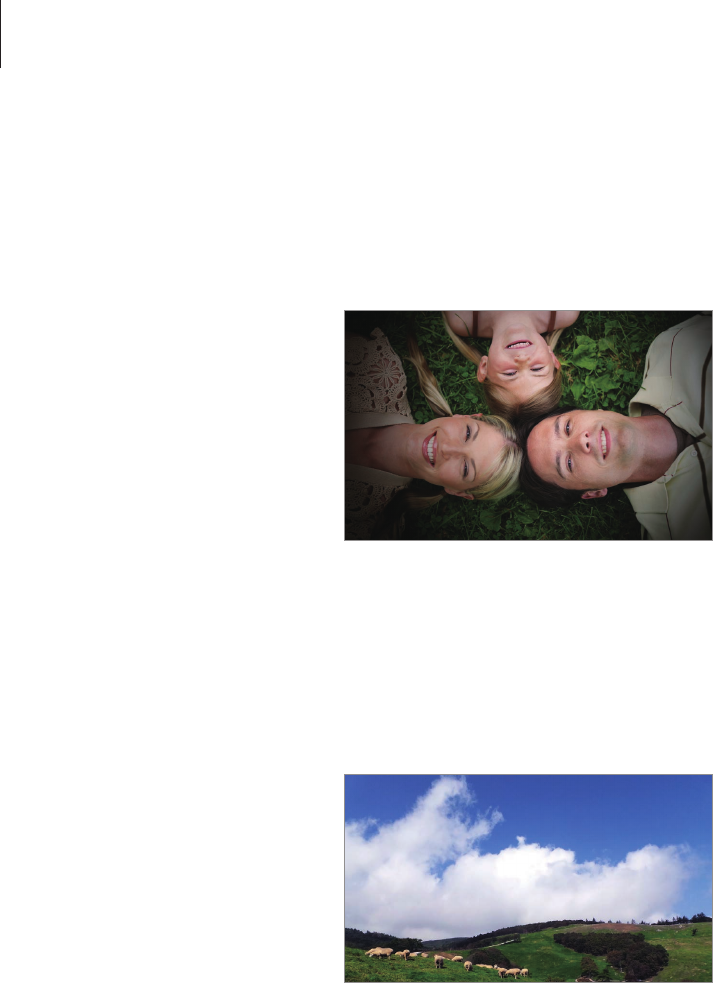
Camera: Shooting modes
65
Vignette+
Use this to highlight the centre by darkening the screen edges.
Tap
MODE
→
Smart
→
Vignette+
.
Landscape
Use this to take photos of blue skies and landscapes with richer colours.
Tap
MODE
→
Smart
→
Landscape
.
Dawn
Use this to take photos of the dawn sky in subtle colours.
Tap
MODE
→
Smart
→
Dawn
.
Snow
Use this to take brighter photos of snow scenery.
Tap
MODE
→
Smart
→
Snow
.
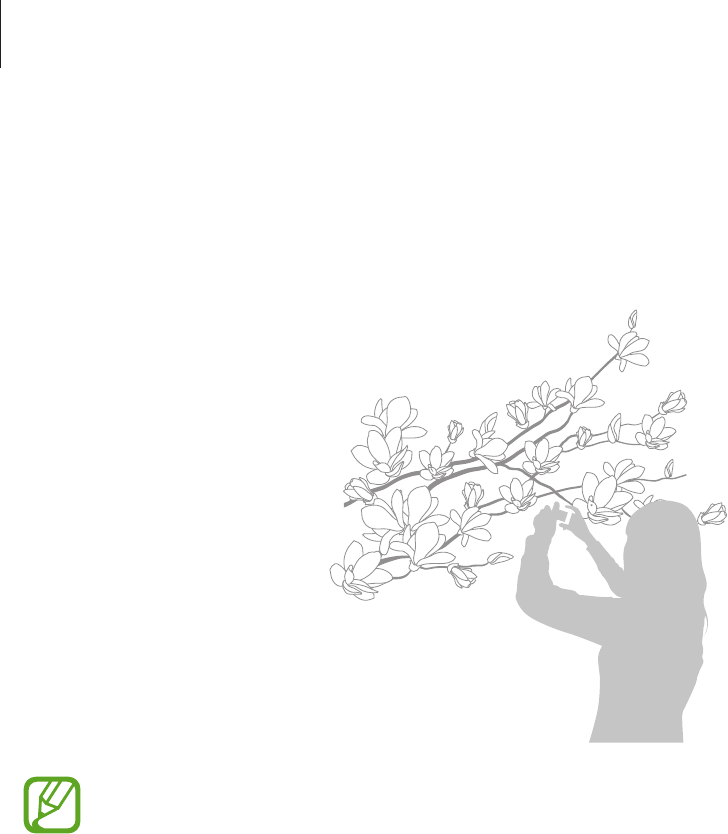
Camera: Shooting modes
66
Macro
Use this to take photos of very close subjects.
Tap
MODE
→
Smart
→
Macro
.
Hold the camera steady to prevent blurry photos.
Food
Use this to take photos of food in more colourful tones.
Tap
MODE
→
Smart
→
Food
.
Party/Indoor
Use this to take crisp indoor photos.
Tap
MODE
→
Smart
→
Party/Indoor
.

Camera: Shooting modes
67
Action freeze
Use this to take photos of subjects moving at high speed.
Tap
MODE
→
Smart
→
Action freeze
.
Use in bright daylight is recommended.
Rich tone
Use this to take photos without losing details in bright and dark areas. The camera
automatically takes several photos with various exposure values, and then merges them into
one photo.
Tap
MODE
→
Smart
→
Rich tone
.
While holding the camera steady, press the Shutter button to take multiple photos.
Without effect With effect

Camera: Shooting modes
68
•
This feature may be affected by camera shake, lighting, movement of the subject,
and shooting environment.
•
The flash is disabled in this feature.
•
When taking a photo of moving subjects, an afterimage may appear.
•
Using a tripod is recommended.
Panorama
Use this to take wide panoramic photos.
Tap
MODE
→
Smart
→
Panorama
.
Press the Shutter button to take a photo, and then move the camera in one direction. When
the blue frame aligns with the preview screen, the camera automatically takes another shot
in the panoramic sequence. To stop shooting, press the Shutter button again. Photos are
automatically combined into one panoramic image.

Camera: Shooting modes
69
•
Avoid the following for best results:
–
Moving the camera too quickly or too slowly.
–
Moving the camera too little to take the next photo.
–
Moving the camera at irregular speeds.
–
Shaking the camera.
–
Changing the camera direction while taking a photo.
–
Taking photos in low-light conditions.
–
Taking photos of moving subjects.
–
Taking photos where the brightness or colour of the light changes.
–
Taking photos of a subject in front of unrecognisable backgrounds, such as
empty skies or plain walls.
•
Photos are automatically saved, and shooting is stopped under following
conditions:
–
Changing the distance from the subject while shooting.
–
Moving the camera too quickly.
–
Not moving the camera.
•
The camera may stop taking photos due to composition or movement within the
scene.
•
The camera may not take the last scene entirely if you stop moving the camera at
the exact position where you want the scene to end. To take the entire scene, move
the camera slightly beyond the position you want the scene to end.
Waterfall
Use this to take photos of waterfalls.
Tap
MODE
→
Smart
→
Waterfall
.
The image may appear blurry due to the slow shutter speed when the camera takes
photos. Make sure to use a tripod.
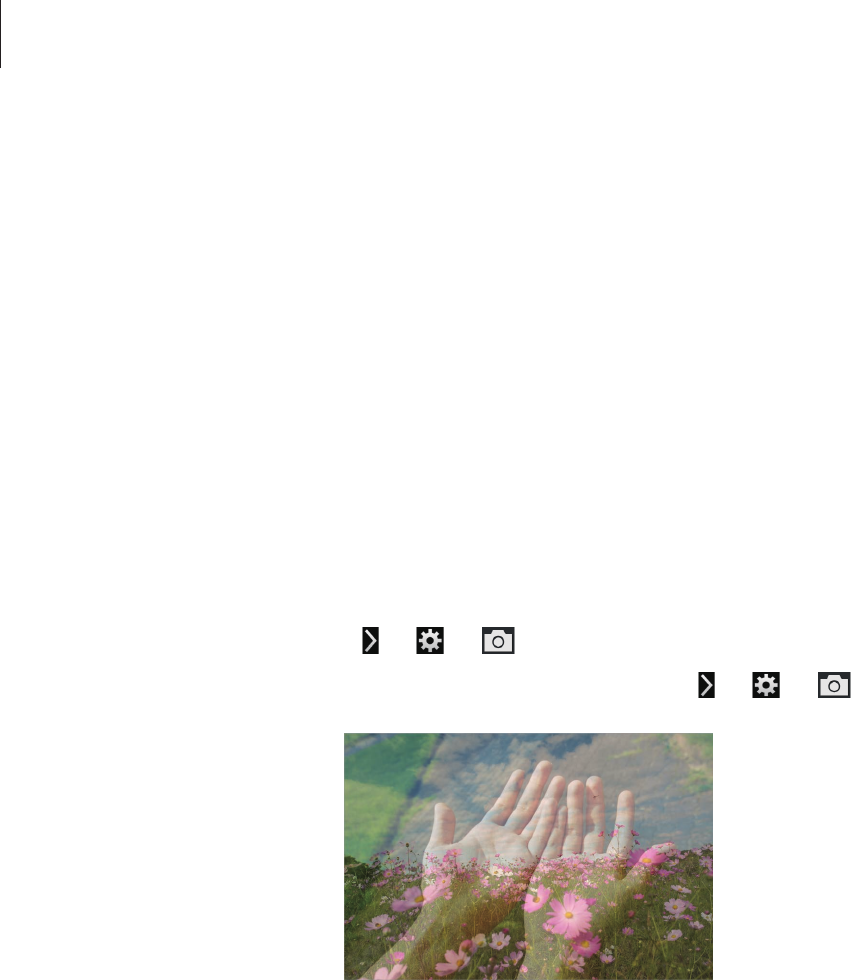
Camera: Shooting modes
70
Animated photo
Use this to create a photo in which selected objects move by freezing or animating moving
objects automatically detected by the camera.
Tap
MODE
→
Smart
→
Animated photo
.
Press the Shutter button to take a photo. Tap
Animate
or
Freeze
, and then rub the screen
to animate or freeze the detected moving objects. Tap
Trim
to adjust the range to trim, or
Direction
to change the direction of the animation. Then, tap
Save
to save the file.
Multi exposure
Use this to take multiple shots and create one photo by overlapping them.
Tap
MODE
→
Smart
→
Multi exposure
.
To set the number of shots, tap
→
→
→
Multi exposure
.
To set the camera to save all photos or only the final result, tap
→
→
→
Save source
.

Camera: Shooting modes
71
Drama
Use this to take a series of photos and combine them to create an image that shows trails of
the movement.
Tap
MODE
→
Smart
→
Drama
.
While holding the camera steady, press the Shutter button to take several photos
continuously. Tap
Save
to save the file.
To get the best shot, follow these tips. The camera may not take photos properly in
other shooting conditions.
•
Hold the camera steady and remain still while taking photos.
•
Take photos of a subject that is moving in one direction.
•
Take photos with backgrounds that are free of moving objects.
•
Avoid taking photos of a subject and background with similar colours.
•
Avoid taking photos of a subject that is too close or too far away to fit within the
screen or that is too long such as a bus or a train.
Eraser
Use this to erase the movements of moving objects in the background.
Tap
MODE
→
Smart
→
Eraser
.
Press the Shutter button to take a series of photos. The camera erases traces of movement
from a moving object. To restore the original photo, tap
Show moving objects
, tap the
highlighted area, and then tap
Save
.

Camera: Shooting modes
72
•
Hold the camera steady and remain still while taking photos.
•
Avoid taking photos of a subject and background with similar colours.
•
When taking photos of a subject that is moving very little or moving a great deal,
the camera may not recognise all of the movements.
•
If there are multiple subjects moving in the background, the camera may not
recognise all of the movement.
Sound & shot
Use this to take a photo with sound.
Tap
MODE
→
Smart
→
Sound & shot
.
The camera records a few seconds of audio before taking a photo.
To record sound after taking a photo, tap
→
→
→
Sound effect
→
Post-shot
.
While taking photos in this mode, sound is recorded by the internal microphone.
Miniature
Use this to apply a miniature effect by making the centre clear and blurring the top and
bottom of the image.
Tap
MODE
→
Smart
→
Miniature
.

Camera: Shooting modes
73
Creative shot
Use this to apply an appropriate filter to a scene automatically detected by the camera.
Tap
MODE
→
Smart
→
Creative shot
.
Interval
Use this to set the interval and number of shots to take over time.
Tap
MODE
→
Smart
→
Interval
.
Silhouette
Use this to take photos of dark shapes against a light background.
Tap
MODE
→
Smart
→
Silhouette
.
To maximise the silhouette effect, take photos at a location that is bright.
Sunset
Use this to take photos of the sunset.
Tap
MODE
→
Smart
→
Sunset
.
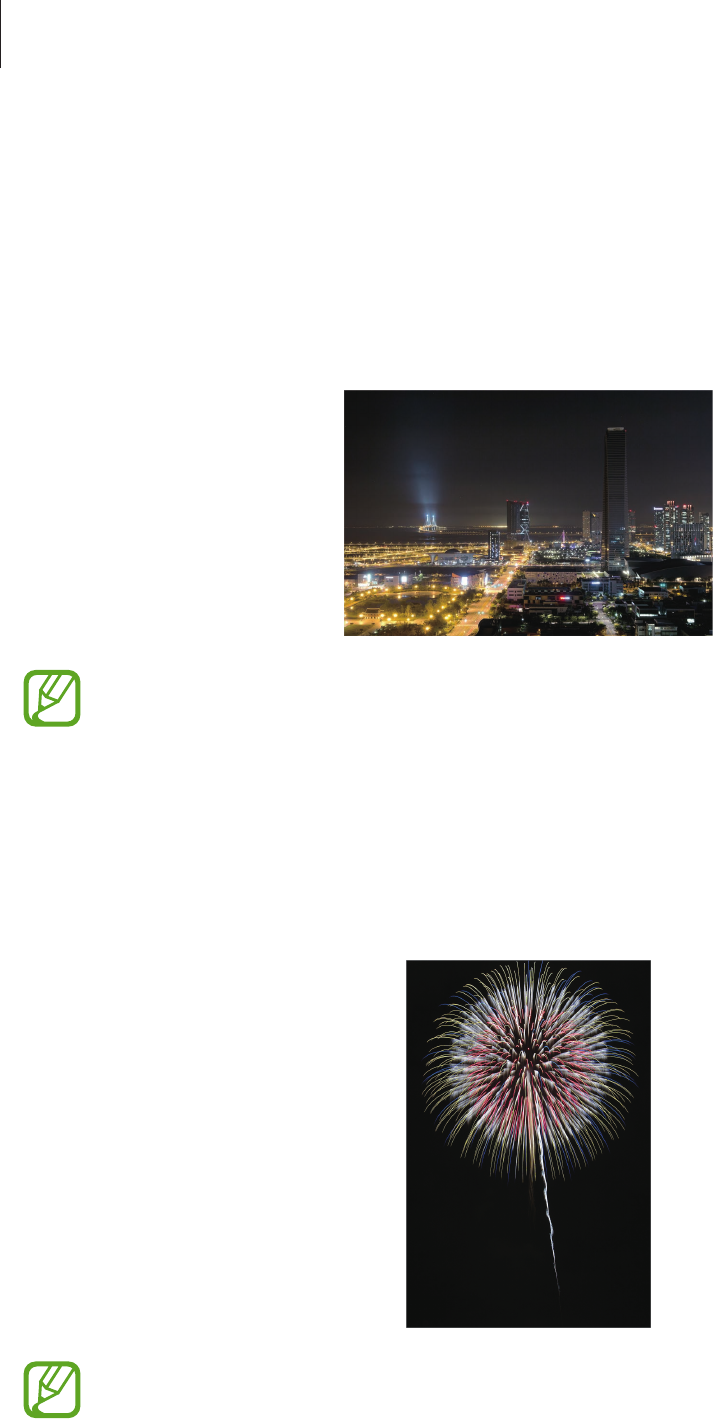
Camera: Shooting modes
74
Night
Use this to take photos in low-light conditions, without using the flash.
Tap
MODE
→
Smart
→
Night
.
While holding the camera steady, press the Shutter button to take multiple photos. Photos
are automatically merged into a single photo.
The image may appear blurry due to the slow shutter speed when the camera takes
photos. Make sure to use a tripod.
Fireworks
Use this to take photos of fireworks.
Tap
MODE
→
Smart
→
Fireworks
.
The image may appear blurry due to the slow shutter speed when the camera takes
photos. Make sure to use a tripod.

Camera: Shooting modes
75
Light trace
Use this to take photos of the light trailing in low-light conditions.
Tap
MODE
→
Smart
→
Light trace
.
The image may appear blurry due to the slow shutter speed when the camera takes
photos. Make sure to use a tripod.
My mode
Use this to register your favourite shooting modes and select them conveniently. You can
register up to 10 modes.
Tap
MODE
→
My mode
→
Add
, and then select your favourite shooting modes. After
completing your selection, tap
Done
to save it.
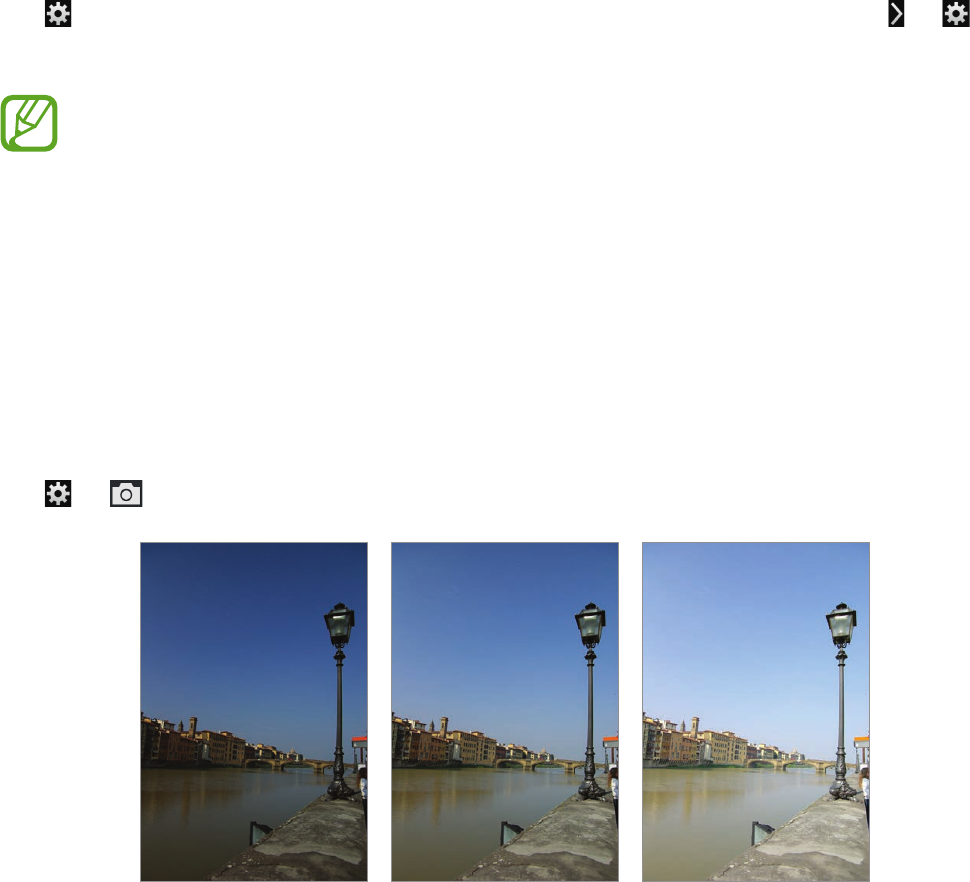
76
Camera: Shooting options and
settings
Customising shooting options
Various shooting options are provided with your camera. With them, you can take more
customised photos and videos.
Tap to access shooting options. Depending on the mode selected, you may tap
→
.
Select an option, and then save it.
•
Available options may differ depending on the shooting mode, the lens you are
using, and the shooting conditions.
•
Depending on the option selected, some settings may not be available.
EV (brightness)
The camera automatically sets the exposure by measuring the levels of light from the photo’s
composition and the position of a subject. If the exposure set by the camera is higher or lower
than you expected, you can adjust the exposure value manually.
Tap
→
→
EV (brightness)
, and select an option.
Darker (-) Neutral (0) Brighter (+)
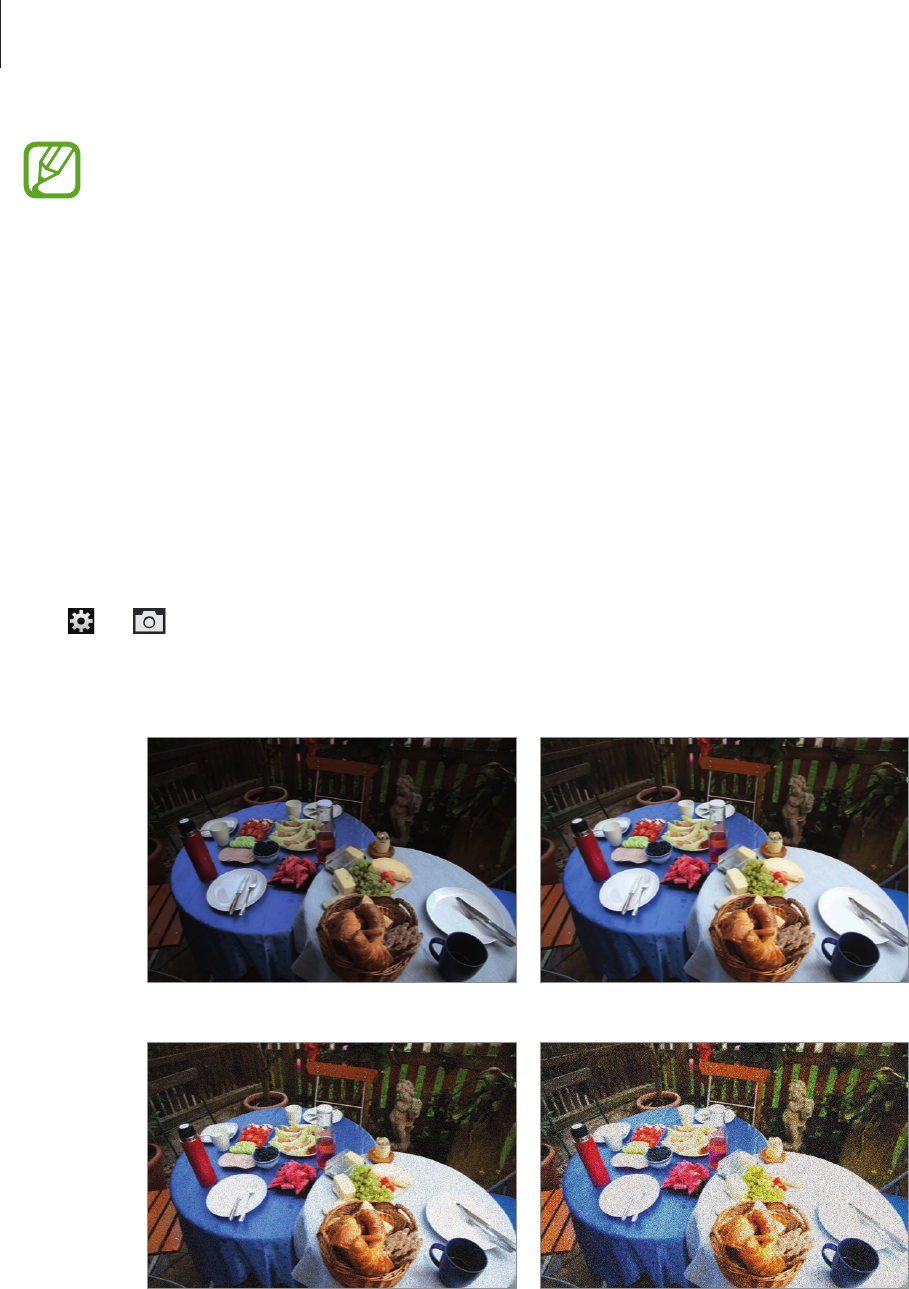
Camera: Shooting options and settings
77
•
When taking a photo, if the appropriate exposure value cannot be decided, use the
bracket set option to take multiple photos with different exposure values.
•
Taking photos with higher exposure values may result in blurry photos, due to
slower shutter speed.
ISO (sensitivity)
The ISO sensitivity value represents the sensitivity of the camera to light.
The higher the ISO sensitivity, the more sensitive the camera is to light. Consequently, by
selecting a higher ISO sensitivity, you can take photos in dim or dark places at faster shutter
speeds. However, this may increase electronic noise and result in a grainy photo.
Tap
→
→
ISO (sensitivity)
, and select an option.
Examples
ISO 100 ISO 400
ISO 800 ISO 3200

Camera: Shooting options and settings
78
•
Increase the ISO sensitivity in places where flash use is prohibited. You can take a
clear photo by setting a high ISO sensitivity without having to secure more light.
•
Use the noise reduction feature to reduce the visual noise that can appear on
photos of a high ISO sensitivity. (p. 92)
WB (light source)
The white balance represents the light source that influences on the colour of a photo.
The colour of a photo depends on the type and quality of the light source. If you want the
colour of your photo to be realistic, select an appropriate lighting condition to calibrate the
white balance, or adjust the colour temperature manually. You can also adjust colour for the
preset light sources so that the colours of the photo match the actual scene under mixed
lighting conditions.
Tap
→
→
WB (light source)
, and select an option.
•
Auto
: Use automatic settings depending on the lighting conditions.
•
Daylight
: Use this for sunny days. This option results in photos closest to the natural
colours of the scene.
•
Cloudy
: Use this for cloudy days or in shadows. Photos taken on cloudy days tend to be
more bluish than on sunny days. This option offsets that effect.
•
Fluorescent_H
: Use this under daylight fluorescent or 3-way fluorescent lights.
•
Fluorescent_L
: Use this under white fluorescent lights.
•
Fluorescent_D
: Use this under a daylight fluorescent lamp.
•
Tungsten
: Use this under incandescent bulbs or halogen lamps. Incandescent tungsten
bulbs tend to have a reddish hue. This option offsets that effect.
•
Flash WB
: Use this when using a flash.
•
Custom set
: Use this to set a custom white balance. Tap , aim the lens at a piece of
white surface, and then press the Shutter button.
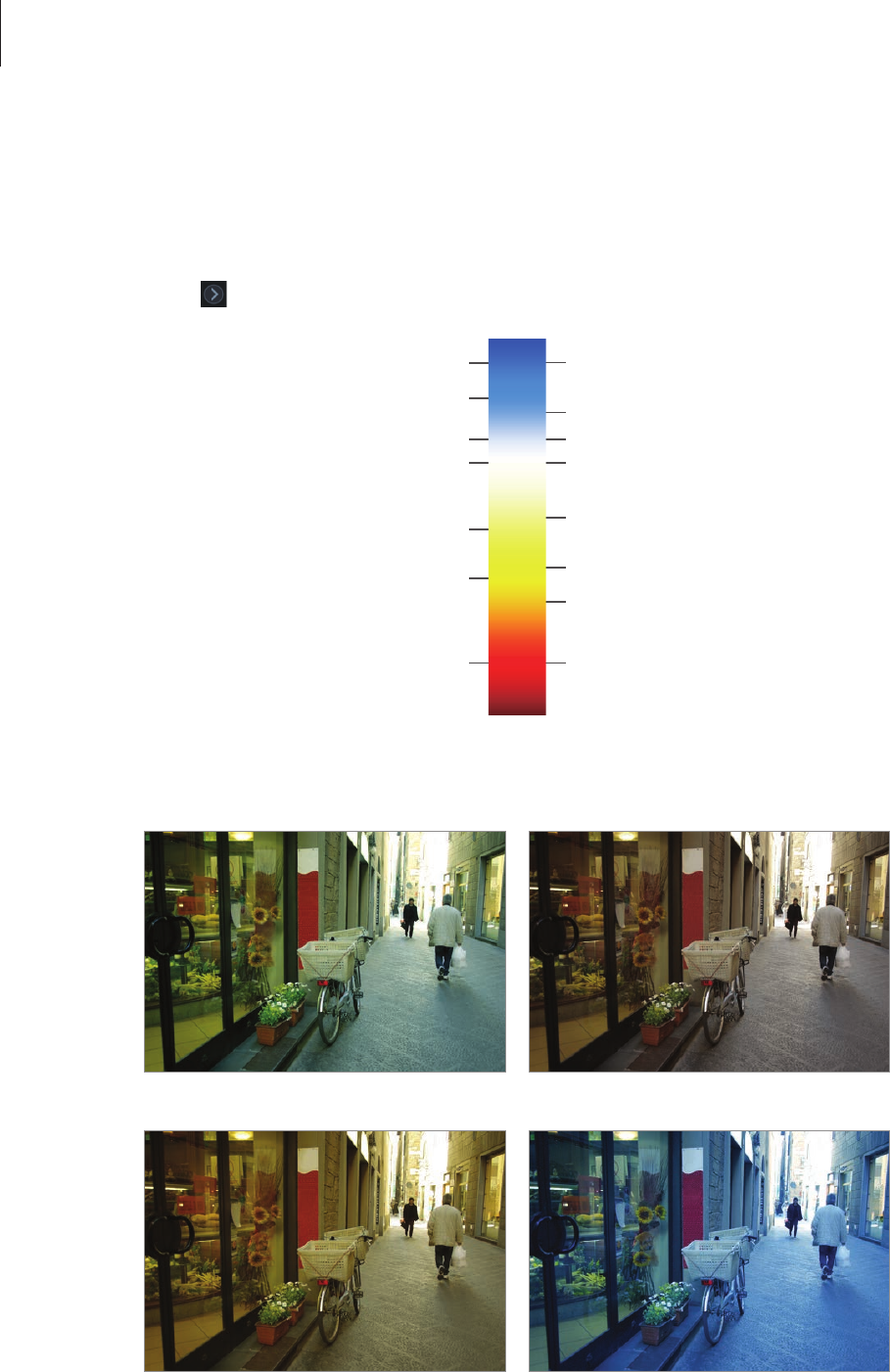
Camera: Shooting options and settings
79
•
K
: Use this to manually adjust the colour temperature of the light source. Colour
temperature is a measurement in degrees Kelvin that indicates the specific type of light
source. As the colour temperature increases, the colour distribution becomes cooler.
Alternatively, as the colour temperature decreases, the colour distribution becomes
warmer. Tap , and then tap +/- to adjust the colour temperature.
Clear sky
10,000 K
8,000 K
6,000 K
5,000 K
4,000 K
3,000 K
2,000 K
Fluorescent H
Cloudy
Daylight
Fluorescent L
Halogen lamp
Tungsten
Candle light
Examples
Auto WB Daylight
Fluorescent daylight Tungsten

Camera: Shooting options and settings
80
Customising preset white balance options
Adjust the colour for the preset light sources.
Tap next to a white balance option. Tap the arrows or tap an area on the screen to adjust
the value on the coordinates.
•
G
: Green
•
A
: Amber
•
M
: Magenta
•
B
: Blue
Metering
The metering mode refers to the method the camera measures the quantity of light.
The camera measures the amount of light in a scene, and in many of its modes, uses the
measurement to adjust various settings. For example, if a subject looks darker than its actual
colour, the camera takes an overexposed photo of it. If a subject looks lighter than its actual
colour, the camera takes an underexposed photo of it.
Tap
→
→
Metering
, and select an option.
•
Multi
: The camera calculates the amount of light in multiple areas. When light is sufficient
or insufficient, the camera adjusts the exposure by averaging the overall brightness of the
scene. This mode is suitable for general photos.
•
Spot
: The camera calculates the amount of light in the centre. When you take a photo
in conditions where there is a strong backlight behind a subject, the camera adjusts the
exposure to shoot a subject correctly.
•
Centre-weighted
: The camera calculates a broader area than the camera does in spot
mode. It sums up the amount of light in the centre portion of the shot (60–80 %) and that
of the rest of the shot (20–40 %).

Camera: Shooting options and settings
81
Drive
Use this option to set the shooting method. Continuous or burst shots are recommended for
shooting the rapid motion of fast moving subjects, such as racing cars.
Tap
→
→
Drive
, and select an option.
•
Single shot
: Use this to take a single photo.
•
Continuous normal
: Use this to take five photos per second continuously while you are
pressing the Shutter button.
•
Continuous high
: Use this to take about eight photos per second continuously while you
are pressing the Shutter button.
•
Burst (10fps)
/
Burst (15fps)
/
Burst (30fps)
: Use this to take 30 photos continuously
when you press the Shutter button once.
•
AE BKT
: Use the auto exposure bracketing option to take three consecutive photos with
different exposure values (one a step lighter, the original, and one a step darker). Use a
tripod to prevent blurry photos. You can adjust the interval range in
Bracket set
. (p. 91)
•
WB BKT
: Use the white balance bracketing option to take three consecutive photos with
different white balance settings (the original and two more with different white balance
settings). The original photo is taken when you press the Shutter button. The other two
are automatically adjusted to the white balance you have set. You can adjust the interval
range in
Bracket set
. (p. 91)
•
Saving photos may take longer depending on memory card capacity and
performance when taking photos continuously.
•
Using a tripod is recommended when taking photos continuously.
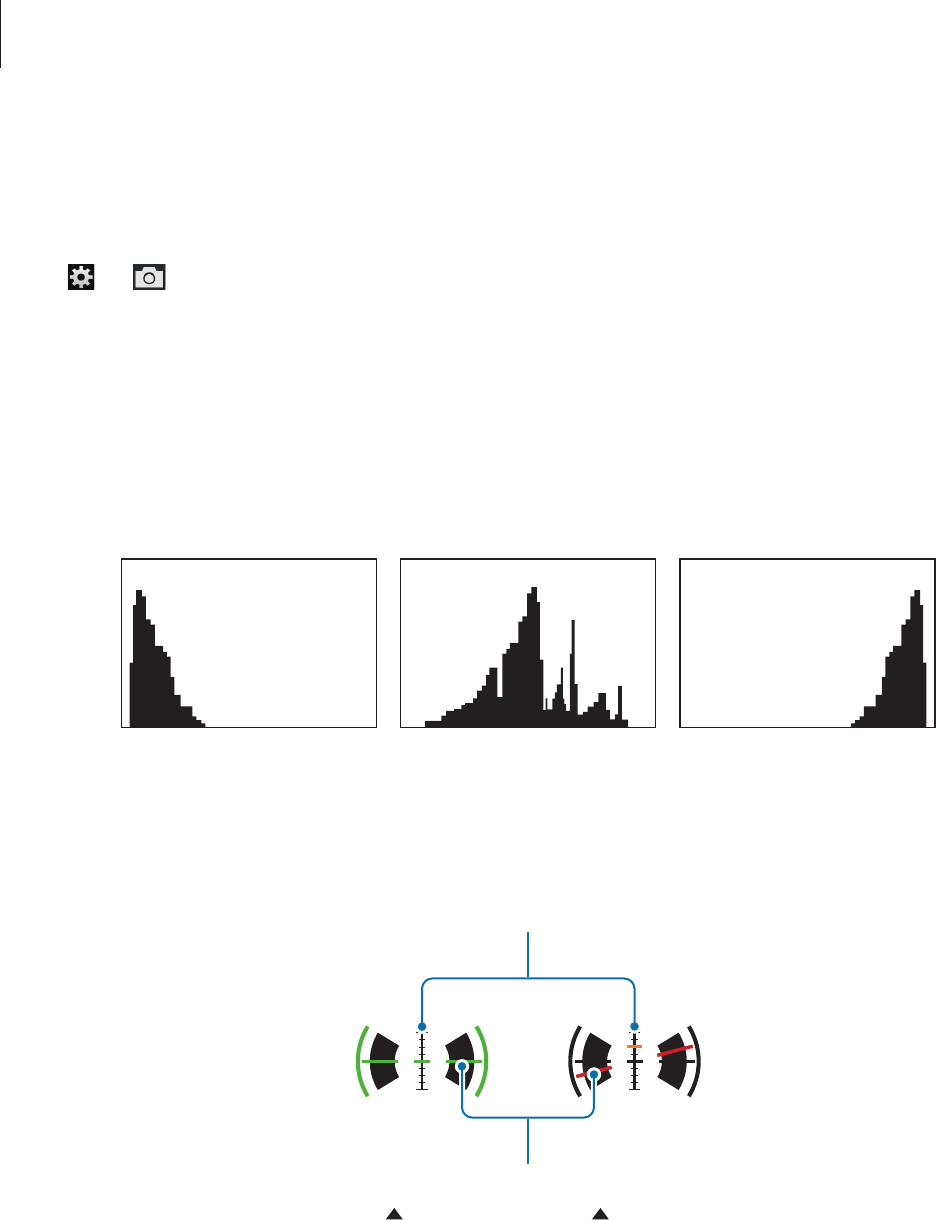
Camera: Shooting options and settings
82
Display
Use this option to add or remove shooting information from the screen.
Tap
→
→
Display
, and select an option.
•
Normal
: The camera displays basic shooting information on the screen.
•
Histogram
: The camera displays the histogram on the screen. A histogram is a graph that
shows the brightness distribution of a photo. A histogram inclined to the left indicates a
dark photo. A histogram inclined to the right indicates a bright photo. The height of the
graph is related to colour information. The graph gets higher if a specific colour is more
common.
Insufficient exposure Balanced exposure Excessive exposure
•
Horizontal level
: The camera displays the level gauge on the screen. The level gauge
helps you align the camera with the horizontal and vertical lines on the screen.
Vertical
Horizontal
Level Unlevel
•
Distance scale
: The camera displays the distance scale on the screen. The distance scale
indicates the distance between a subject and the camera. This function is available only
when you attach a lens that supports the distance scale function.
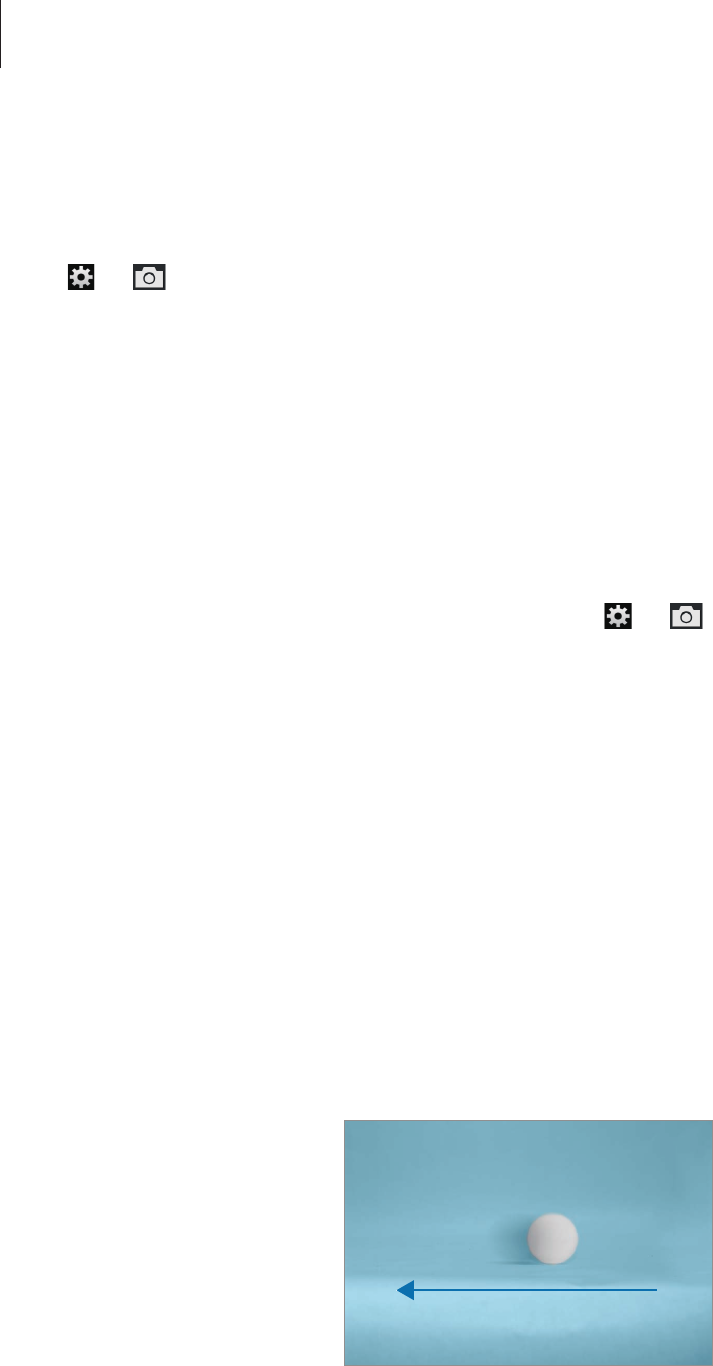
Camera: Shooting options and settings
83
Save as User mode
Use this to save the current settings as your own shooting mode.
Tap
→
→
Save as User mode
.
Flash
To take a realistic photo of a subject, the amount of light should be constant. When the light
source varies, you can use a flash and supply a constant amount of light.
In auto mode, the flash pops up automatically when you half-press the Shutter button or tap
the screen in low-light conditions.
Press the Flash release button to pop the flash up, tap
→
→
Flash
, and then select an
option.
•
Off
: Use this to turn the flash off.
•
Smart flash
: Use this to automatically adjust the brightness of the flash according to the
amount of light in the surrounding environment.
•
Auto flash
: Use this to automatically use the flash. The flash fires when the subject or
background is dark.
•
Auto + Red-eye
: Use this to automatically use the flash and reduce red-eyes.
•
Fill in
: Use this to always use the flash.
•
Fill in + Red-eye
: Use this to always use the flash and reduce red-eyes.
•
1st Curtain
: Use this to fire the flash immediately after the shutter opens. The camera
takes a photo of a subject earlier in an action sequence clearly.
Ball moving direction

Camera: Shooting options and settings
84
•
2nd Curtain
: Use this to fire the flash just before the shutter closes. The camera takes a
photo of a subject later in an action sequence clearly.
Ball moving direction
•
Keep the flash retracted when not in use to avoid damage.
•
Forcing the flash to open may cause damage to the camera.
•
Use only Samsung-approved flashes. Using incompatible flashes may damage your
camera.
•
There is an interval between two bursts of the flash. Do not move until the flash
fires a second time.
•
If you select
Off
, the flash does not fire even when an external flash is attached.
•
If light from the flash is reflected, or if a substantial amount of dust is in the air, tiny
spots may appear in the photo.
•
If you attach an intensity-adjustable external flash to the camera, the intensity
settings of the flash will be applied.
•
If the subject is too close when you use the flash, some light may be blocked,
resulting in a dark photo. Ensure that the subject is within the recommended
range, which varies by lenses.
•
When a lens hood is attached, the light from the flash can be blocked by the hood.
Remove the hood to use the flash.
Adjusting the flash intensity
When the flash is on, adjust the flash intensity.
Tap next to an option, and then drag the slider or tap or to adjust the intensity.
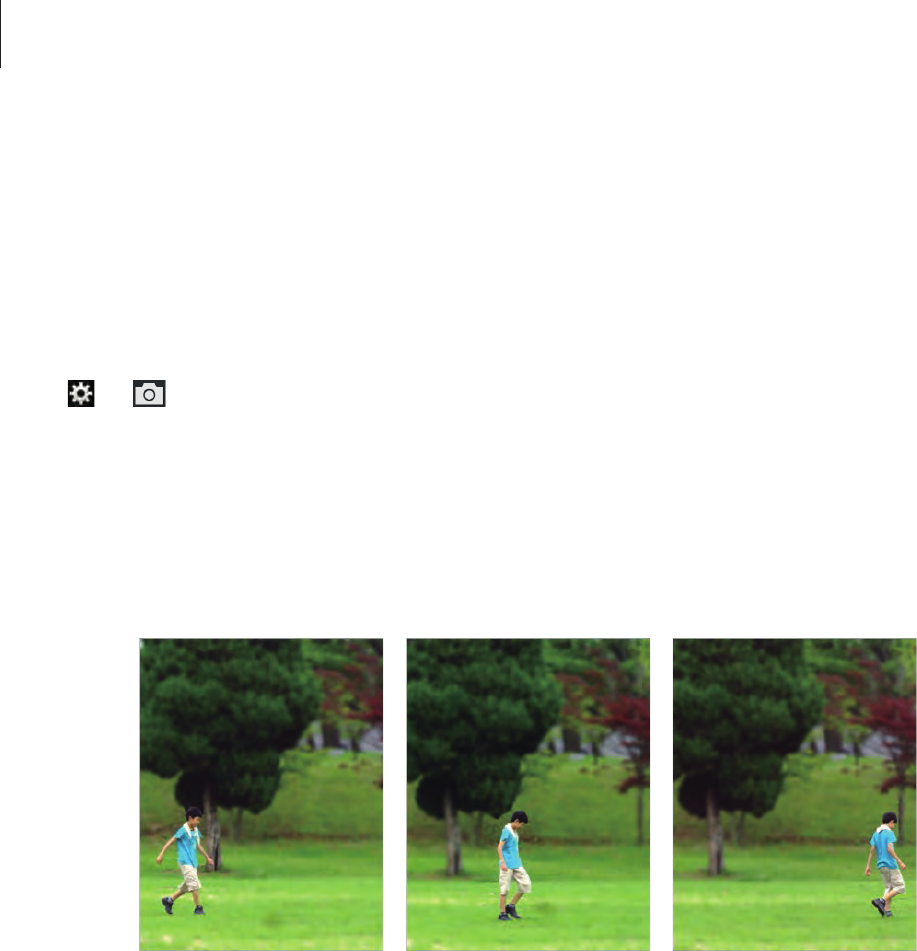
Camera: Shooting options and settings
85
AF mode
Use this option to select a focus mode appropriate to the subject.
If the lens has an AF/MF switch, you must set the switch to select the focus mode that you
require. Set the switch to AF to select either
Single AF
or
Continuous AF
. Set the switch to MF
to select
Manual focus
.
Tap
→
→
AF mode
, and select an option.
•
Single AF
: Use this to capture a still subject. When you half-press the Shutter button, the
focus fixes in the focus area. The area turns green when the focus is achieved.
•
Continuous AF
: Use this to capture fast moving subjects. When you half-press the Shutter
button, the camera continues to focus. Once the focus area is fixed on the subject, the
subject is always in focus even when moving.
•
Manual focus
: Use this to manually focus on a subject by rotating the focus ring on the
lens.
MF Assist
helps you achieve a focus easily. While you are rotating the focus ring, the
focus area is magnified. (p. 89) When you use
Focus Peaking
, the colour you selected
appears on the focused subject. (p. 89)

Camera: Shooting options and settings
86
AF Area
Use this option to change the positions of the focus area.
Generally, cameras focus on the nearest subject. When there are a lot of subjects, however,
unwanted subjects can be in focus. To prevent unwanted subjects from being in focus,
change the focus area so that a desired subject is in focus. You can get a clearer and sharper
photo by selecting an appropriate focus area.
Tap
→
→
AF Area
, and select an option.
•
Center AF
: Use this to focus on the centre of the frame.
•
Multi AF
: Use this to focus on multiple areas. The photo is divided into two or more areas,
and the camera obtains focus points of each area and displays a green rectangle in places
where focus is set correctly. This option is recommended for scenery photos.
•
Face Detection
: Use this to focus on human faces preferentially. This option is
recommended for shooting a group of people.
This feature may not be effective in the following conditions:
•
The subject is too far from the camera.
•
The lighting is too bright or too dark.
•
The subject is not facing the device.
•
The subject is wearing sunglasses or a mask.
•
The subject’s facial expression changes drastically.
•
The subject is backlit, or the lighting conditions are unstable.

Camera: Shooting options and settings
87
•
Tracking AF
: Use this to track and automatically focus on your subject, even when the
subject is moving or when you change the shooting composition.
•
Tracking a subject may fail in the following conditions:
–
The subject is too small.
–
The subject moves excessively.
–
The subject is backlit or you are shooting in a dark place.
–
Colours or patterns on the subject and the background are the same.
–
The subject includes horizontal patterns, such as blinds.
–
The camera shakes excessively.
•
If the camera fails to track the subject, the focus area will be reset.
•
If the camera fails to focus, the focus frame will change to red the focus will be
reset.
•
One touch shot
: Use this to take a photo with the touch of your finger. As you touch on
the subject, the camera focuses on the subject and takes a photo automatically.
Photo size
As you increase the resolution, your photo will include more pixels, so it can be printed on
larger paper or displayed on a larger screen. When you use a high resolution, the file size
will also increase. Select a low resolution for photos that will be displayed in a digital picture
frame or uploaded to the web.
Tap
→
→
Photo size
, and select an option.

Camera: Shooting options and settings
88
Quality
Use this option to select a higher photo quality for better photos. Selecting a higher photo
quality also increases the file size.
Tap
→
→
Quality
, and select an option.
The camera saves photos in either the jpg or raw file format. Photos in the jpg format are
stored in the memory according to the settings of the camera at the time of shooting.
However, raw format files are not transformed to jpg and are saved in the memory without
any changes.
Raw format files have the srw file extension. To convert raw format files into other file formats
or to calibrate exposures, white balance, tones, contrasts, and colours, use the Adobe
Photoshop Lightroom program found on the supplied DVD-ROM. Ensure you have enough
space in the memory to save photos in the raw file format.
Installing Adobe Photoshop Lightroom
Insert the Adobe Photoshop Lightroom DVD into your computer, select a language, and then
follow the on-screen instructions to complete the installation.
With Adobe Photoshop Lightroom, you can convert or calibrate image files, including jpg, tiff,
and raw file formats. For more information, refer to the program guide.
Image Adjust
Use this option to adjust the colour, saturation, sharpness, or contrast of your photos.
Tap
→
→
Image Adjust
, and drag the slider or tap or for each value.

Camera: Shooting options and settings
89
Timer
Use this option to take photos with a delay of time.
Tap
→
→
Timer
, and select an option.
Press the Shutter button to start the timer. The camera takes photos after a specified length of
time. Press the Shutter button to cancel the timer.
MF assist
Use this option to enlarge the scene and easily adjust the focus while rotating the focus ring.
Tap
→
→
MF assist
, and select an option.
•
Off
: Use to turn this option off.
•
Enlarge x5
: Use this to magnify the focus area by 5 times when you rotate the focus ring.
Focus peaking
Use this option to set the colour you selected appears on the focused subject to help you
focus while rotating the focus ring.
Tap
→
→
Focus peaking
, and select an option.
•
Level
: Use this to set a sensitivity level for detecting the focused subject.
•
Color
: Use this to set a colour to appear on the focused subject.
Link AE to AF Point
Use this option to measure the exposure value of the focus area. When this option is on, the
camera automatically sets an optimal exposure by calculating the brightness of the focus
area.
Tap
→
→
Link AE to AF Point
, and turn this option on or off.

Camera: Shooting options and settings
90
Framing mode
When you adjust the aperture value or shutter speed, the exposure value changes according
to the settings, so the display may darken. When this option is on, the brightness of the
display is constant regardless of the settings, so you can better frame your shot.
Tap
→
→
Framing mode
, and turn this option on or off.
OIS (anti-shake)
Use the Optical Image Stabiliser (OIS) option to reduce or eliminate blurriness from camera
shake.
If your lens has an OIS switch, set the switch to ON to use the OIS feature.
Tap
→
→
OIS (anti-shake)
, and select an option.
•
Off
: Use to turn this option off.
•
Mode1
: Use this to apply the OIS feature only when you press the Shutter button in full or
half.
•
Mode2
: Use this to continuously apply the OIS feature.
Without OIS correction With OIS correction

Camera: Shooting options and settings
91
•
This feature may not function properly in the following conditions:
–
When you move the camera to follow a moving subject.
–
If the camera is shaking too much.
–
When the shutter speed is slow (for example, when taking photos in low-light
conditions).
–
If the battery power is low.
–
When you take close-up photos.
•
Using this feature with a tripod may blur photos because of vibration from the OIS
sensor. Deactivate this feature when using a tripod.
•
The display may be blurry if the camera is hit or dropped. When this happens,
restart the device.
Bracket set
Use this option to change the settings for auto exposure bracketing and white balance
bracketing.
Tap
→
→
Bracket set
, and select an option.
•
AE Bracket set
: Use this to adjust the exposure interval range of the three bracketed
photos.
•
WB Bracket set
: Use this to adjust the white balance interval range of the three bracketed
photos.
ISO customizing
Use this option to change the settings for the ISO sensitivity.
Tap
→
→
ISO customizing
, and select an option.
•
ISO step
: Use this to set the size for the ISO sensitivity by either 1/3 or one step.
•
Auto ISO Range
: Use this to set the maximum ISO value under which each EV step is
chosen when you set the ISO sensitivity to
Auto
.

Camera: Shooting options and settings
92
DMF
Use the Direct Manual Focus (DMF) option to adjust the focus manually by rotating the focus
ring after achieving the focus by half-pressing the Shutter button.
Tap
→
→
DMF
, and turn this option on or off.
AF priority
Use this option to take a photo only if the focus is set correctly when you press the Shutter
button.
Turn this option on to always get a properly focused photo. Turn it off to take a photo
regardless of focus.
Tap
→
→
AF priority
, and turn this option on or off.
When you take continuous or burst shots, the camera will take photos even if this
option is turned on and the subject is not in focus.
Noise reduction
Use this option to reduce the visual noise in photos.
Tap
→
→
Noise reduction
, and select an option.
•
High ISO NR
: Use this to reduce noise that may occur when you set a high ISO sensitivity.
You can adjust the noise reduction intensity by selecting one from
High
,
Normal
, and
Low
.
•
Long term NR
: Use this to reduce noise when you set the camera for a long exposure.
Distortions correct
Use this option to correct distortion that might occur from lenses.
Tap
→
→
Distortions correct
, and turn this option on or off.

Camera: Shooting options and settings
93
Color space
Use this option to select methods for representing colours. Digital imaging devices, such as
digital cameras, monitors, and printers, have their own methods for representing colours,
which are called colour spaces.
Tap
→
→
Color space
, and select an option.
•
S RGB
: sRGB (Standard RGB) is an international specification to define the colour space
created by IEC (International Electrotechnical Commission). It is widely used for creating
colours on computer monitors and is also the standard colour space for Exif. sRGB is
recommended for regular images and images you intend to publish on the Internet.
•
Adobe RGB
: Adobe RGB is used for commercial printing and has a larger colour range
than sRGB. Its wider range of colours helps you to easily edit photos on a computer.
Note that individual programs are generally compatible with a limited number of colour
spaces.
The rule for creating file names varies depending on the selected colour space option.
•
sRGB files: YYYYMMDD_hhmmss.JPG. For example, for a photo taken on Jan.
02, 2013, at 15:30:45, the file name would be 20130102_153045.jpg. File names
for continuous or burst photos would be YYYYMMDD_hhmmss_x.JPG, for the
previous example, the file name would be 20130102_153045_1.JPG.
•
Adobe RGB files: YYYYMMDD_hhmmss_A.JPG. File names for continuous or burst
photos would be YYYYMMDD_hhmmss_Ax.JPG.
Dynamic range
Use this option to correct the loss of bright detail that can occur due to shading differences in
a photo.
Tap
→
→
Dynamic range
, and select an option.
•
Off
: Use to turn this option off.
•
Smart Range+
: Use this to correct the loss of bright detail.
•
HDR
: Use this to take two photos with different exposure values and combine them to
create a single image.

Camera: Shooting options and settings
94
Over exposure guide
Use this option to set the camera to indicate the overexposed area on the preview screen.
Tap
→
→
Over exposure guide
, and turn this option on or off.
Video recording options
Tap
→
, and configure the settings for video recording.
•
Movie size
: Select a resolution for videos. Use higher resolution for higher quality. Higher
resolution videos take up more memory.
•
Quality
: Set the quality level for videos. Higher quality images require more storage
space.
•
Multi motion
: Set the playing speed of videos.
If you select an option other than
x1
, sound will not be recorded.
•
Voice
: Set the camera to record sound with videos.
•
Windcut
: Remove some surrounding noise in addition to wind noise.
Sharing options
Share photos as they are taken by setting sharing options. Tap
→
, and select an option.
•
Share shot
: Send a photo directly to another device via Wi-Fi Direct.
•
Buddy photo share
: Set the camera to recognise a person’s face that you have tagged in
a photo and send it to that person.
•
ChatON photo share
: Send a photo directly to another device via ChatON.
•
Remote viewfinder
: Set a mobile device to control the camera remotely.

Camera: Shooting options and settings
95
Camera settings
Tap
→
, and configure the settings for Camera.
•
AF sound
: Adjust the auto focus sound.
•
Beep
: Activate or deactivate beep sounds.
•
Description
: Display mode descriptions.
•
Guidelines
: Display a guide to help you compose a scene.
•
Display brightness
: Set the brightness of the screen.
•
Auto screen off
: Set the length of time the device waits before turning off the display’s
backlight.
•
Review
: Briefly display photos or videos taken.
•
Signature
: Use this to add a signature on the photo.
•
Date/time Imprint
: Use this to imprint the date and/or the time on the photos when
taking them.
•
GPS tag
: Attach a GPS location tag to the photo. Activate this feature when taking photos
to create albums in
Story Album
or use the photo suggestion feature.
•
To improve GPS signals, avoid shooting in locations where the signal may be
obstructed, such as between buildings or in low-lying areas, or in poor weather
conditions.
•
Your location may appear on your photos when you upload them to the Internet.
To avoid this, deactivate the GPS tag setting.

Camera: Shooting options and settings
96
•
Voice control
: Activate or deactivate the voice recognition to take photos.
•
Contextual filename
: Set the camera to add contextual tags, such as location
information, to filenames.
To use this feature, you must activate the GPS tag setting.
•
AF lamp
: Use this to activate the AF-assist light in low-light conditions.
•
Power-on mode
: Select the default camera mode that launches when the device is
turned on.
•
EVF dial control
: Select items to control with the EVF dial.
•
Storage
: Select the memory location for storage.
•
Display select
: Use this to set the proximity/light sensor to automatically adjust between
the screen and the viewfinder, or to always use the screen.
•
Sensor cleaning
: Use this to remove dust from the image sensor.
•
Lens firmware
: Update the firmware of the lens.
•
Reset
: Reset the camera settings.

97
Media
Gallery
Use this application to view images and videos.
Tap
Gallery
on the Applications screen.
•
Some file formats are not supported depending on the software installed on the
device.
•
Some files may not play properly depending on the encoding method used.
Viewing images
Launching
Gallery
displays available folders. When another application, such as
Email
, saves
an image, the
Download
folder is automatically created to contain the image. Likewise,
capturing a screenshot automatically creates the
Screenshots
folder. Select a folder to open
it.
In a folder, images are displayed by creation date. Select an image to view it in full screen.
Scroll left or right to view the next or previous image.
Continuous and burst photos appear as a bundle in the thumbnails view.
Tap the thumbnail to view individual photos.
Zooming in and out
Use one of the following methods to zoom in an image:
•
Double-tap anywhere to zoom in.
•
Spread two fingers apart on any place to zoom in. Pinch to zoom out, or double-tap to
return.

Media
98
Viewing images using the motion feature
When an image is zoomed in, tap and hold a point on the screen, and then move the device
in any direction to browse the image.
On the Applications screen, tap
Settings
→
My device
→
Motions and gestures
→
Motion
,
drag the
Motion
switch to the right, and then turn on the switch for
Browse an image
.
To stop using the motion feature, turn off the switch for the feature.
Playing videos
Video files show the icon on the preview. Select a video to watch it and tap .
Editing images
When viewing an image, tap and use the following functions:
•
Edit
: Launch
Photo Wizard
or
Paper Artist
to edit the image.
•
Details
: View image details.
•
Slideshow
: Start a slideshow with the images in the current folder.
•
Favourite
: Add the image to favourites.
•
Signature
: Add a signature to the image. Signatures are saved in the
Mysignature
folder.
•
Copy to clipboard
: Copy to clipboard.
•
Rotate left
: Rotate anticlockwise.
•
Rotate right
: Rotate clockwise.
•
Crop
: Resize the blue frame to crop and save the image in it.
•
Buddy photo share
: Send the image to a person whose face is tagged in the image.
•
Print
: Print the image via a USB or Wi-Fi connection. The device is only compatible with
some Samsung printers.
•
Show on map
: View the shooting location on the map. When taking a photo or video,
enable geotagging to attach GPS location tag with the photo or video. If there is no GPS
location tag to attach, this option does not appear.
•
Rename
: Rename the file.
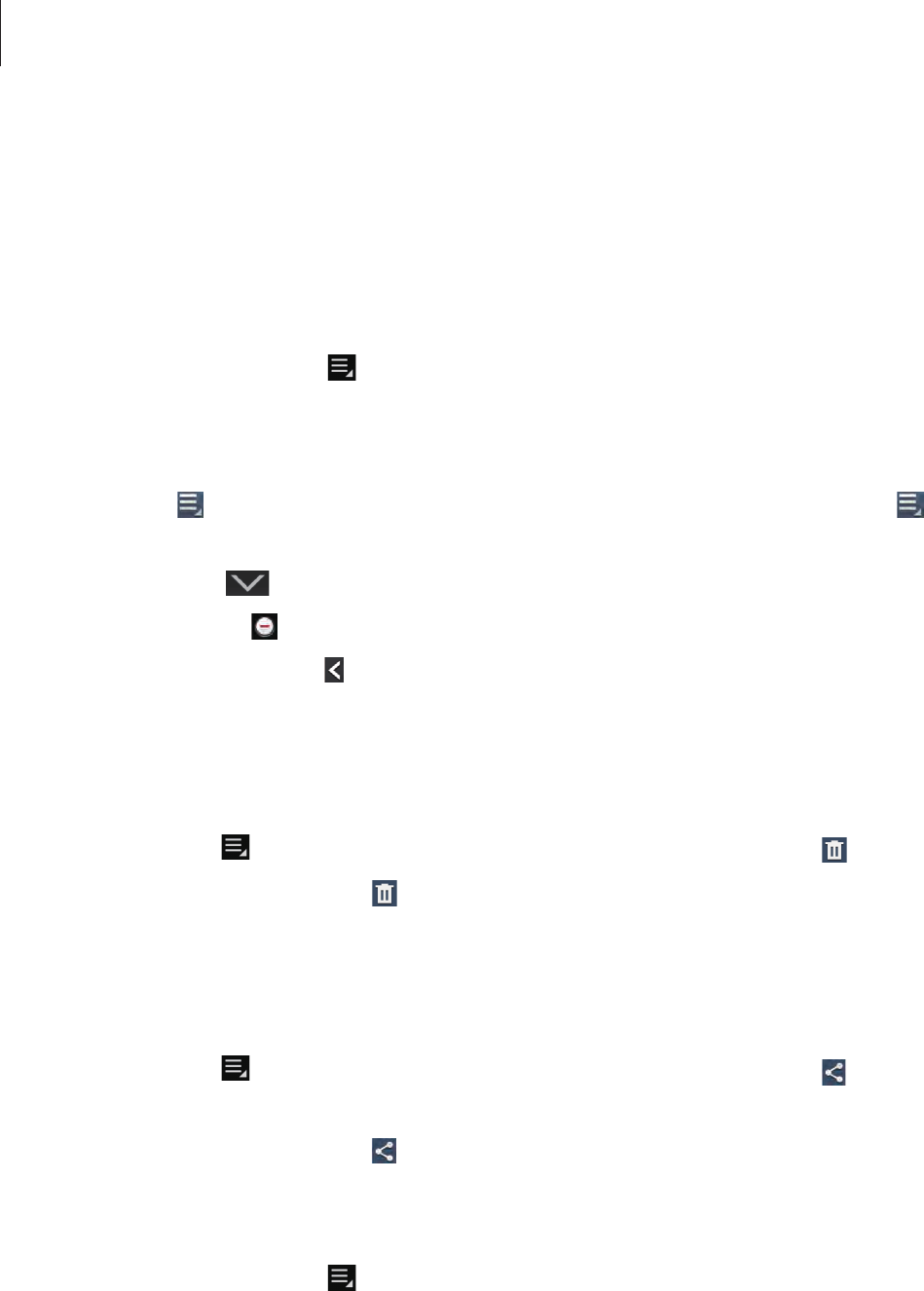
Media
99
•
Scan for nearby devices
: Search for devices that have media sharing activated.
•
Set as
: Set the image as wallpaper or a contact image.
•
Settings
: Change the Gallery settings.
Favourite images
When viewing an image, tap
→
Favourite
to add the image to the favourites list.
Making image collages
In a folder, tap
→
Select item
, select two to four images by ticking, and then tap
→
Create collage
. Select a style at the bottom of the screen, and then tap
Save
.
To add images, tap
→
Add picture
.
To delete images, tap .
To change the split type, tap .
Deleting images
Use one of the following methods:
•
In a folder, tap
→
Select item
, select images by ticking, and then tap .
•
When viewing an image, tap .
Sharing images
Use one of the following methods:
•
In a folder, tap
→
Select item
, select images by ticking, and then tap to send them
to others.
•
When viewing an image, tap to send it to others.
Setting as wallpaper
When viewing an image, tap
→
Set as
to set the image as wallpaper or to assign it to a
contact.
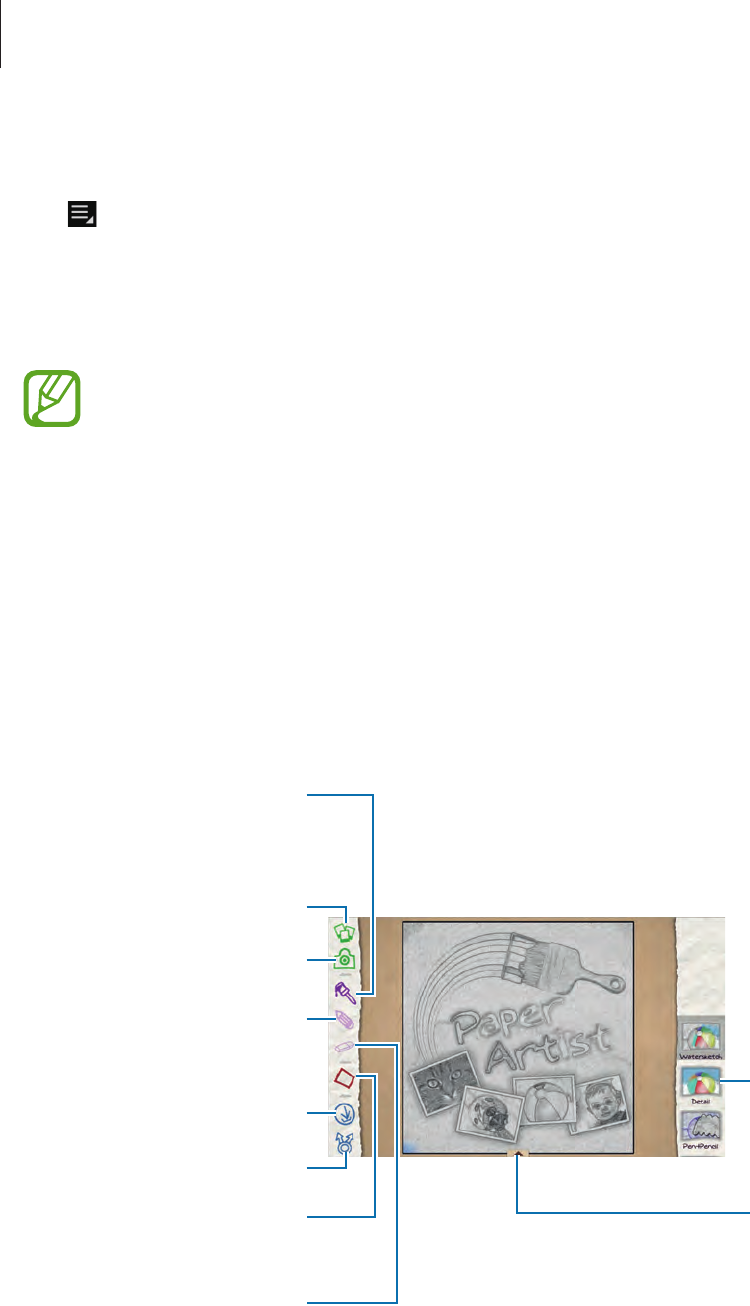
Media
100
Tagging faces
Tap
→
Settings
, and then tick
Face tag
. A yellow frame appears around the recognised
face on an image. Tap the face, tap
Add name
, and then select or add a contact.
When the face tag appears on an image, tap the face tag and use available options, such as
sending messages.
Face recognition may fail depending on the face angle, face size, skin colour, facial
expression, light conditions, or accessories the subject is wearing.
Paper Artist
Use this application to make images look like illustrations with fun effects or frames.
Tap
Paper Artist
on the Applications screen.
Use artistic tools to edit an image. The edited image is saved in
Gallery
→
Paper Pictures
folder.
Select an existing image.
Share the image.
Apply effects to the image.
Open the panel to undo
and redo the last action.
Draw with a pen. Tap to
change the pen thickness.
Take a photo.
Draw with a brush. Tap to
change the brush
thickness.
Save the image.
Apply frames to the
image.
Erase the drawings. Tap to
change the eraser size.
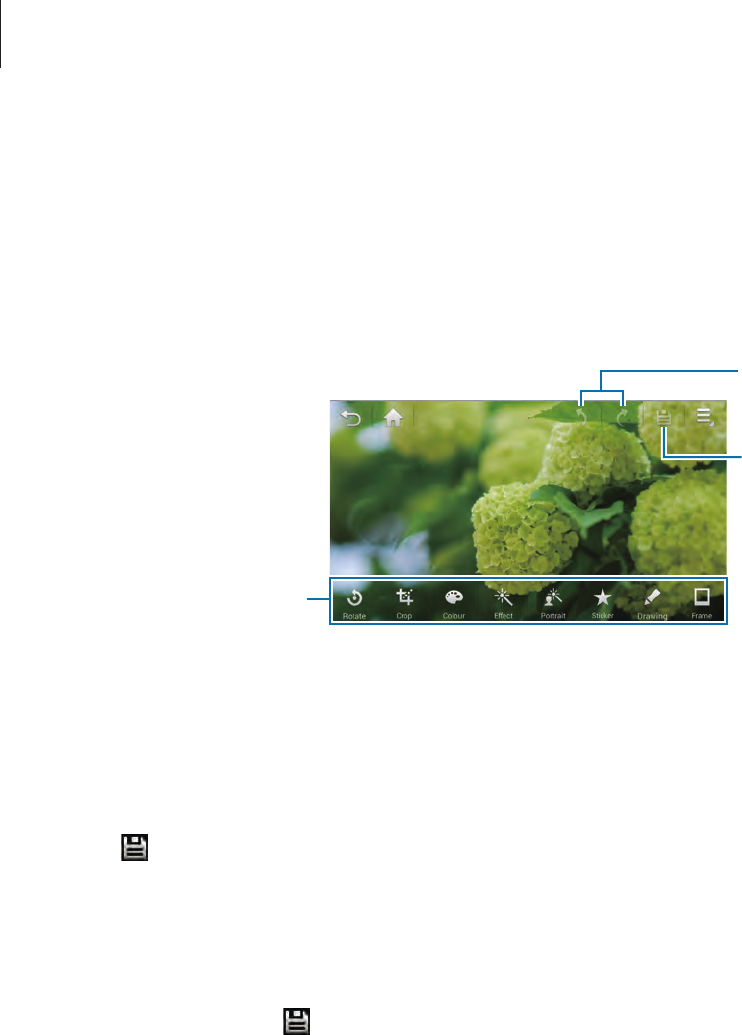
Media
101
Photo Wizard
Use this application to embellish images by applying various effects, such as the pop art
effect.
Tap
Photo Wizard
on the Applications screen.
Undo and redo the last
action.
Save changes.
Edit the image.
To select an area to edit, tap and hold the screen, and then tap
Selection mode
.
Rotating images
Tap
Rotate
, select an option at the bottom of the screen, or drag the screen to rotate, and
then tap .
Cropping photos
Tap
Crop
, select an option at the bottom of the screen, rotate or resize the frame by dragging
the frame, and then tap .

Media
102
Changing colours
Tap
Colour
, select one of the colour effects that appear at the bottom of the screen, drag the
slider to left or right if required, and then tap .
Applying filter effects
Tap
Effect
, select one from among the filter effects that appear at the bottom of the screen,
drag the slider to left or right if required, and then tap .
Adjusting a portrait photo
Tap
Portrait
, select one of the portrait effects that appear at the bottom of the screen, drag
the slider to left or right if required, and then tap .
Putting stickers on images
Tap
Sticker
, select one of the stickers that appear at the bottom of the screen, and then tap
.
Drawing on images
Tap
Drawing
, draw on the image, and then tap .
Framing images
Tap
Frame
, select one of the frames that appear at the bottom of the screen, and then tap .

Media
103
Video
Use this application to play video files.
Tap
Video
on the Applications screen.
•
Some file formats are not supported depending on the device's software.
•
Some files may not play properly depending on the encoding method used.
Playing videos
Select a video to play.
Change screen ratio.
Move forwards or
backwards by dragging
the bar.
Scan DLNA-enabled
devices.
Restart the current video
or skip to the previous
video. Tap and hold to
move backwards quickly.
Skip to the next video. Tap
and hold to move
forwards quickly.
Adjust the volume.
Reduce the size of the
video screen.
Pause and resume
playback.
Deleting videos
Tap
→
Delete
, select videos by ticking, and then tap
Delete
.
Sharing videos
Tap
→
Share via
, select videos by ticking, tap
Done
, and then select a sharing method.

Media
104
Using Popup Video player
Use this feature to use other applications without closing the video player. While watching
videos, tap to use the pop-up player.
Spread two fingers apart on the screen to enlarge the player or pinch to reduce it. To move
the player, drag the player to another location.
Video Editor
Use this application to edit videos and apply various effects.
Tap
Video Editor
on the Applications screen.
•
Some video files in
Gallery
may not be viewable depending on video resolution
and codec.
•
Some files may not play properly depending on the encoding method used.
Creating videos
Tap to create a new project, and then select a frame theme. To add media files, tap the
icon corresponding to the desired media type at the bottom left pane of the screen, and then
tap a file. Repeat file insertion as needed, and then tap
Done
to finish.
To delete a frame, tap and hold the frame, and then drag it to the rubbish bin.
To rearrange frames, tap and hold a frame, and then drag it to a new location.
Tap and add a transition effect between frames.
To save, tap
→
Save
.
To export the video as a file, tap
→
Export
.
Inserting text in a video
Select a frame to edit, enter text by using text insertion options at the right pane, and then
save the video.

Media
105
Trimming segments of a video
Select a frame to split, move the start bracket to the desired starting point, move the end
bracket to the desired ending point, tap
Done
, and then save the video.
Splitting videos
Select a frame to split, drag it to the split point, tap
Done
, and then save the video.
Applying effects to a video
Select a frame to edit, select an effect option at the left pane, and then save the video.
Story Album
Use this application to create your own digital album to keep your stories by organising the
images neatly and automatically.
Tap
Story Album
on the Applications screen.
Creating story albums
Tap
Create album
→
By tag information
to create a story album automatically. Select
criteria, and then tap
Find pictures
. Enter a title for the album, select a theme, and then tap
Create album
.
To create it manually, tap
Create album
→
From Gallery
.
Creating recommended albums
When you take photos at one location, the device automatically sorts your photos into
albums based on your specified criteria and suggests making the new albums.
Tap
→
Settings
→
Home city
, and then set a method for recognising your location. Select
an album type and set a minimum number of photos.

Media
106
When you take photos that meet the criteria you set, the device will suggest making an
album.
Tap
Create album
→
From suggestions
. Select an album, enter a title for the album, and
then tap
Save
.
The device will recommend making story albums when you surpass the preset
number of photos in a single day.
Viewing story albums
Select a story album. The cover image appears on the first page. Scroll left or right to view
images in the story album.
When viewing an image, tap and use the following functions:
•
Add content
: Add more content to the current page.
•
Remove content
: Delete content on the current page.
•
Change theme
: Change the theme for the page layout.
•
Slideshow
: Start a slideshow with the images in the current album or change the
slideshow settings.
•
Share via
: Send the album to others.
•
Print
: Print the album via a USB or Wi-Fi connection. The device is only compatible with
some Samsung printers.
•
Order photo book
: Place an order for a printed album.
•
Export
: Export the album to other storage locations.
•
Delete album
: Delete the album.
Editing images
Tap the image of the page in an album.
To add a caption, tap .
To send the image to others, tap .
To delete the image, tap .
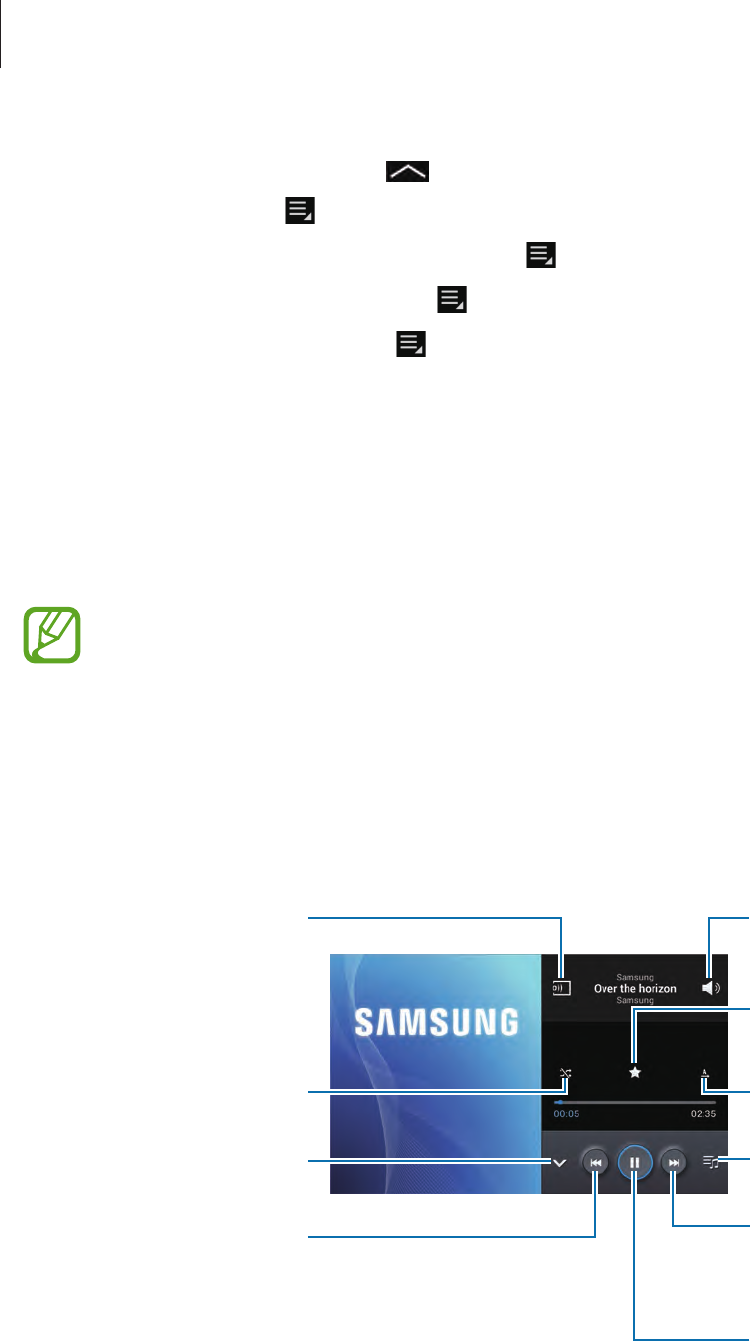
Media
107
To apply effects to the image, tap .
To start a slideshow, tap
→
Slideshow
→
Start slideshow
.
To set the image as an album cover image, tap
→
Set as cover
.
To rotate the image anticlockwise, tap
→
Rotate left
.
To rotate the image clockwise, tap
→
Rotate right
.
Music
Use this application to listen to music.
Tap
Music
on the Applications screen.
•
Some file formats are not supported depending on the device’s software version.
•
Some files may not play properly depending on the encoding method used.
Playing music
Select a music category, and then select a song to play.
Tap the album image at the bottom of the screen to open the music player screen.
Skip to the next song. Tap
and hold to move
forwards quickly.
Pause and resume
playback.
Adjust the volume.
Open the playlist.
Change the repeat mode.
Restart the
currently-playing song or
skip to the previous song.
Tap and hold to move
backwards quickly.
Turn on shue.
Hide the music player
screen.
Scan DLNA-enabled
devices.
Set the file as your
favourite song.

Media
108
To listen to songs at equal volume levels, tap
→
Settings
→
Smart volume
.
When
Smart volume
is activated, the volume may end up louder than the device
volume level. Use caution to avoid long-term exposure to loud sounds to prevent
damage to your hearing.
Creating playlists
Make an own selection of songs.
Tap
Playlists
, and then tap
→
Create playlist
. Enter a title and tap
OK
. Tap
Add music
,
select songs to include, and then tap
Done
.
To add the currently-playing song to a playlist, tap
→
Add to playlist
.
Playing music by mood
Play music grouped by mood. The playlist is automatically created by the device. When a new
song is added, tap
Music square
→
→
Library update
.
Tap
Music square
and select a cell of mood. Or select multiple cells by dragging your finger.
YouTube
Use this application to watch videos from the YouTube website.
Tap
YouTube
on the Applications screen.
This application may not be available depending on the region or service provider.
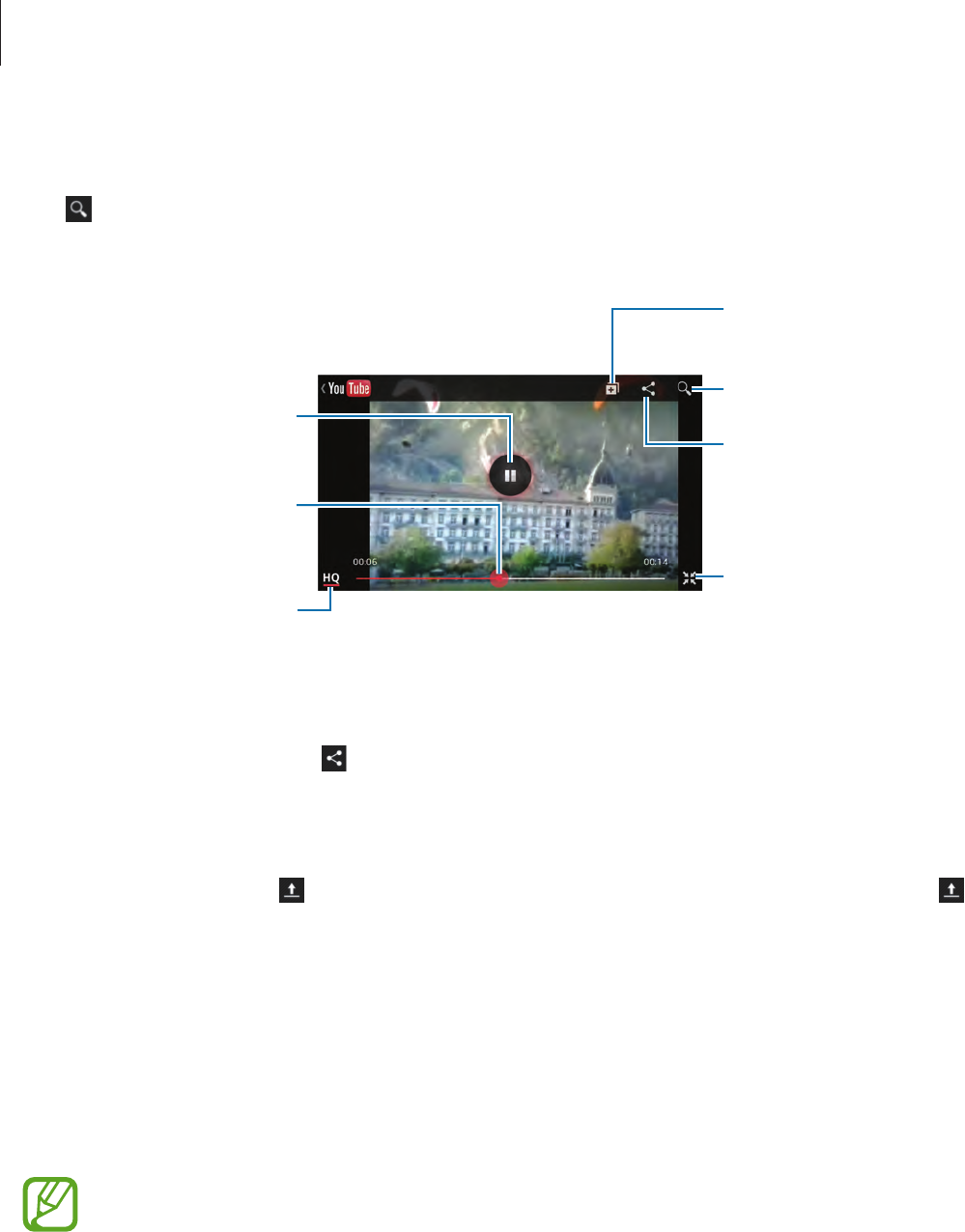
Media
109
Watching videos
Tap , and then enter a keyword. Select one of the returned search results to watch a video.
Rotate the device to landscape orientation to display full screen.
Pause or resume playback.
Move forwards or
backwards by dragging
the bar.
Change display quality.
Add the video to the
playlist.
Search for videos.
Rotate the screen to
portrait orientation.
Send the URL to others.
Sharing videos
Select the video to view, tap , and then select a sharing method.
Uploading videos
Select your account, tap , select a video, enter information for the video, and then tap .
Weather Widget
Use this application to get the current weather and forecasts for your current location or
other regions.
Tap
Weather Widget
on the Applications screen.
This application may not be available depending on the region or service provider.

Media
110
Adding locations
To add a location, enter a place name in the search box, or tap to find the current location.
To add more locations, tap
My city list
→
Add
.
Deleting locations
Tap
My city list
, tap
→
Delete
, select locations by ticking, and then tap
Done
.
To delete the current location, tap
→
Settings
, and then deselect
Show current
city
.
Switching between locations
Scroll left or right at the left side of the screen.
PhotoSuggest
Use this application to view photos taken by other users of points of interest near your
current location.
Tap
PhotoSuggest
on the Applications screen.
Viewing photos
Based on your current location, the device suggests photos of nearby places on a map. Search
for a place and tap a thumbnail photo to view it in full screen.
While viewing a photo, tap
→
Add to favourites
/
places to visit
, add the photo or place to
the favourites list, and turn on the notification setting. You will be notified when you visit the
place in the photo.
Using photos as a shooting guide
You can use the suggested photos as guides for shooting the same or similar places.
While viewing a photo, tap . The camera application launches and displays the photo. Use
the shooting angle and composition in the photo as a guide for taking your own shot.